Australasian Accounting, Business and Finance Journal Volume 8 |
VerifiedAdded on 2022/11/07
|19
|11003
|3
AI Summary
You have to answer questions in 'Journal Article Critique'. Assignment clarification for one question is also given.
Contribute Materials
Your contribution can guide someone’s learning journey. Share your
documents today.
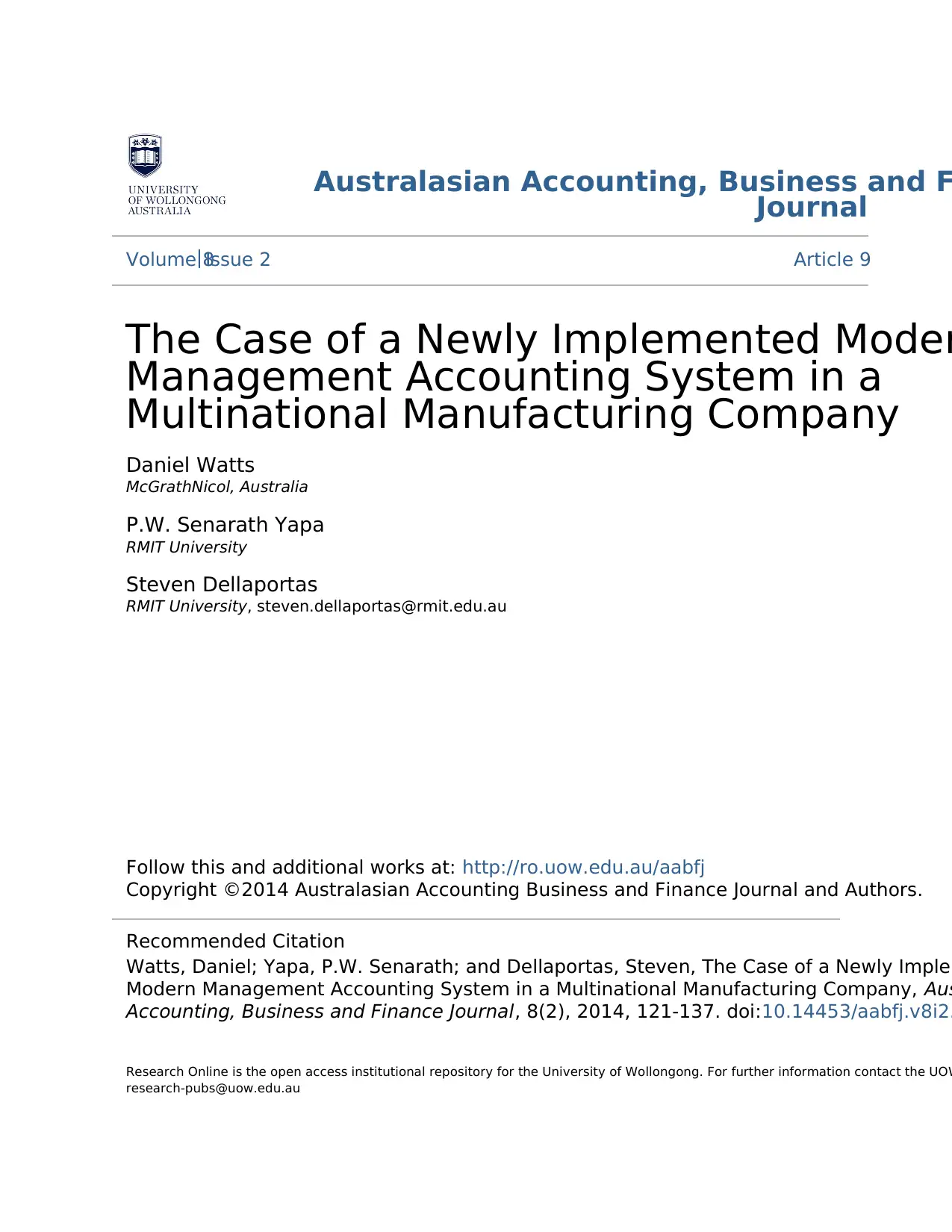
Australasian Accounting, Business and F
Journal
Volume 8| Issue 2 Article 9
The Case of a Newly Implemented Moder
Management Accounting System in a
Multinational Manufacturing Company
Daniel Watts
McGrathNicol, Australia
P.W. Senarath Yapa
RMIT University
Steven Dellaportas
RMIT University, steven.dellaportas@rmit.edu.au
Follow this and additional works at: http://ro.uow.edu.au/aabfj
Copyright ©2014 Australasian Accounting Business and Finance Journal and Authors.
Research Online is the open access institutional repository for the University of Wollongong. For further information contact the UOW
research-pubs@uow.edu.au
Recommended Citation
Watts, Daniel; Yapa, P.W. Senarath; and Dellaportas, Steven, The Case of a Newly Implem
Modern Management Accounting System in a Multinational Manufacturing Company, Aus
Accounting, Business and Finance Journal, 8(2), 2014, 121-137. doi:10.14453/aabfj.v8i2.
Journal
Volume 8| Issue 2 Article 9
The Case of a Newly Implemented Moder
Management Accounting System in a
Multinational Manufacturing Company
Daniel Watts
McGrathNicol, Australia
P.W. Senarath Yapa
RMIT University
Steven Dellaportas
RMIT University, steven.dellaportas@rmit.edu.au
Follow this and additional works at: http://ro.uow.edu.au/aabfj
Copyright ©2014 Australasian Accounting Business and Finance Journal and Authors.
Research Online is the open access institutional repository for the University of Wollongong. For further information contact the UOW
research-pubs@uow.edu.au
Recommended Citation
Watts, Daniel; Yapa, P.W. Senarath; and Dellaportas, Steven, The Case of a Newly Implem
Modern Management Accounting System in a Multinational Manufacturing Company, Aus
Accounting, Business and Finance Journal, 8(2), 2014, 121-137. doi:10.14453/aabfj.v8i2.
Secure Best Marks with AI Grader
Need help grading? Try our AI Grader for instant feedback on your assignments.
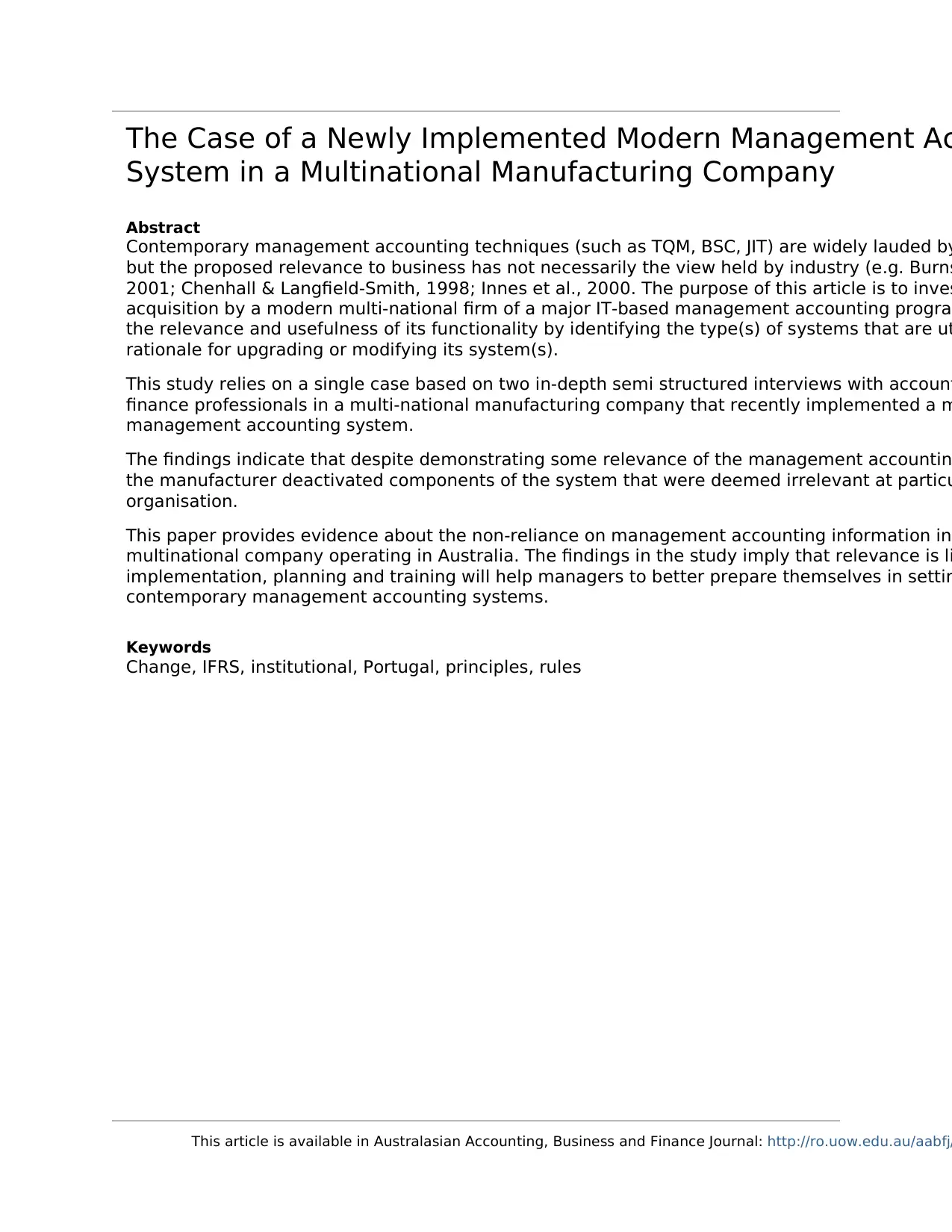
The Case of a Newly Implemented Modern Management Ac
System in a Multinational Manufacturing Company
Abstract
Contemporary management accounting techniques (such as TQM, BSC, JIT) are widely lauded by
but the proposed relevance to business has not necessarily the view held by industry (e.g. Burns
2001; Chenhall & Langfield-Smith, 1998; Innes et al., 2000. The purpose of this article is to inves
acquisition by a modern multi-national firm of a major IT-based management accounting program
the relevance and usefulness of its functionality by identifying the type(s) of systems that are ut
rationale for upgrading or modifying its system(s).
This study relies on a single case based on two in-depth semi structured interviews with account
finance professionals in a multi-national manufacturing company that recently implemented a m
management accounting system.
The findings indicate that despite demonstrating some relevance of the management accountin
the manufacturer deactivated components of the system that were deemed irrelevant at particu
organisation.
This paper provides evidence about the non-reliance on management accounting information in
multinational company operating in Australia. The findings in the study imply that relevance is li
implementation, planning and training will help managers to better prepare themselves in settin
contemporary management accounting systems.
Keywords
Change, IFRS, institutional, Portugal, principles, rules
This article is available in Australasian Accounting, Business and Finance Journal: http://ro.uow.edu.au/aabfj/
System in a Multinational Manufacturing Company
Abstract
Contemporary management accounting techniques (such as TQM, BSC, JIT) are widely lauded by
but the proposed relevance to business has not necessarily the view held by industry (e.g. Burns
2001; Chenhall & Langfield-Smith, 1998; Innes et al., 2000. The purpose of this article is to inves
acquisition by a modern multi-national firm of a major IT-based management accounting program
the relevance and usefulness of its functionality by identifying the type(s) of systems that are ut
rationale for upgrading or modifying its system(s).
This study relies on a single case based on two in-depth semi structured interviews with account
finance professionals in a multi-national manufacturing company that recently implemented a m
management accounting system.
The findings indicate that despite demonstrating some relevance of the management accountin
the manufacturer deactivated components of the system that were deemed irrelevant at particu
organisation.
This paper provides evidence about the non-reliance on management accounting information in
multinational company operating in Australia. The findings in the study imply that relevance is li
implementation, planning and training will help managers to better prepare themselves in settin
contemporary management accounting systems.
Keywords
Change, IFRS, institutional, Portugal, principles, rules
This article is available in Australasian Accounting, Business and Finance Journal: http://ro.uow.edu.au/aabfj/
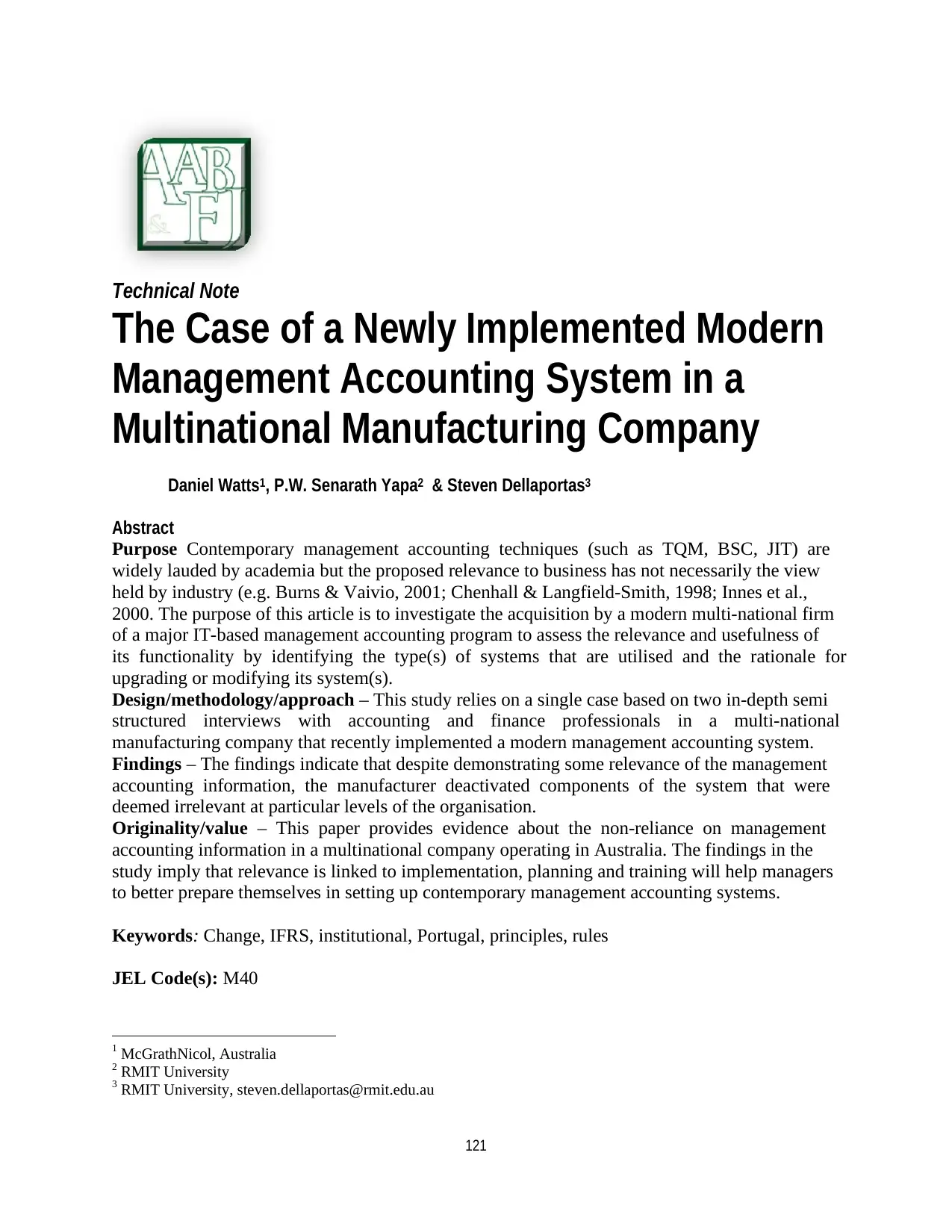
121
Technical Note
The Case of a Newly Implemented Modern
Management Accounting System in a
Multinational Manufacturing Company
Daniel Watts1, P.W. Senarath Yapa2 & Steven Dellaportas3
Abstract
Purpose Contemporary management accounting techniques (such as TQM, BSC, JIT) are
widely lauded by academia but the proposed relevance to business has not necessarily the view
held by industry (e.g. Burns & Vaivio, 2001; Chenhall & Langfield-Smith, 1998; Innes et al.,
2000. The purpose of this article is to investigate the acquisition by a modern multi-national firm
of a major IT-based management accounting program to assess the relevance and usefulness of
its functionality by identifying the type(s) of systems that are utilised and the rationale for
upgrading or modifying its system(s).
Design/methodology/approach – This study relies on a single case based on two in-depth semi
structured interviews with accounting and finance professionals in a multi-national
manufacturing company that recently implemented a modern management accounting system.
Findings – The findings indicate that despite demonstrating some relevance of the management
accounting information, the manufacturer deactivated components of the system that were
deemed irrelevant at particular levels of the organisation.
Originality/value – This paper provides evidence about the non-reliance on management
accounting information in a multinational company operating in Australia. The findings in the
study imply that relevance is linked to implementation, planning and training will help managers
to better prepare themselves in setting up contemporary management accounting systems.
Keywords: Change, IFRS, institutional, Portugal, principles, rules
JEL Code(s): M40
1 McGrathNicol, Australia
2 RMIT University
3 RMIT University, steven.dellaportas@rmit.edu.au
Technical Note
The Case of a Newly Implemented Modern
Management Accounting System in a
Multinational Manufacturing Company
Daniel Watts1, P.W. Senarath Yapa2 & Steven Dellaportas3
Abstract
Purpose Contemporary management accounting techniques (such as TQM, BSC, JIT) are
widely lauded by academia but the proposed relevance to business has not necessarily the view
held by industry (e.g. Burns & Vaivio, 2001; Chenhall & Langfield-Smith, 1998; Innes et al.,
2000. The purpose of this article is to investigate the acquisition by a modern multi-national firm
of a major IT-based management accounting program to assess the relevance and usefulness of
its functionality by identifying the type(s) of systems that are utilised and the rationale for
upgrading or modifying its system(s).
Design/methodology/approach – This study relies on a single case based on two in-depth semi
structured interviews with accounting and finance professionals in a multi-national
manufacturing company that recently implemented a modern management accounting system.
Findings – The findings indicate that despite demonstrating some relevance of the management
accounting information, the manufacturer deactivated components of the system that were
deemed irrelevant at particular levels of the organisation.
Originality/value – This paper provides evidence about the non-reliance on management
accounting information in a multinational company operating in Australia. The findings in the
study imply that relevance is linked to implementation, planning and training will help managers
to better prepare themselves in setting up contemporary management accounting systems.
Keywords: Change, IFRS, institutional, Portugal, principles, rules
JEL Code(s): M40
1 McGrathNicol, Australia
2 RMIT University
3 RMIT University, steven.dellaportas@rmit.edu.au
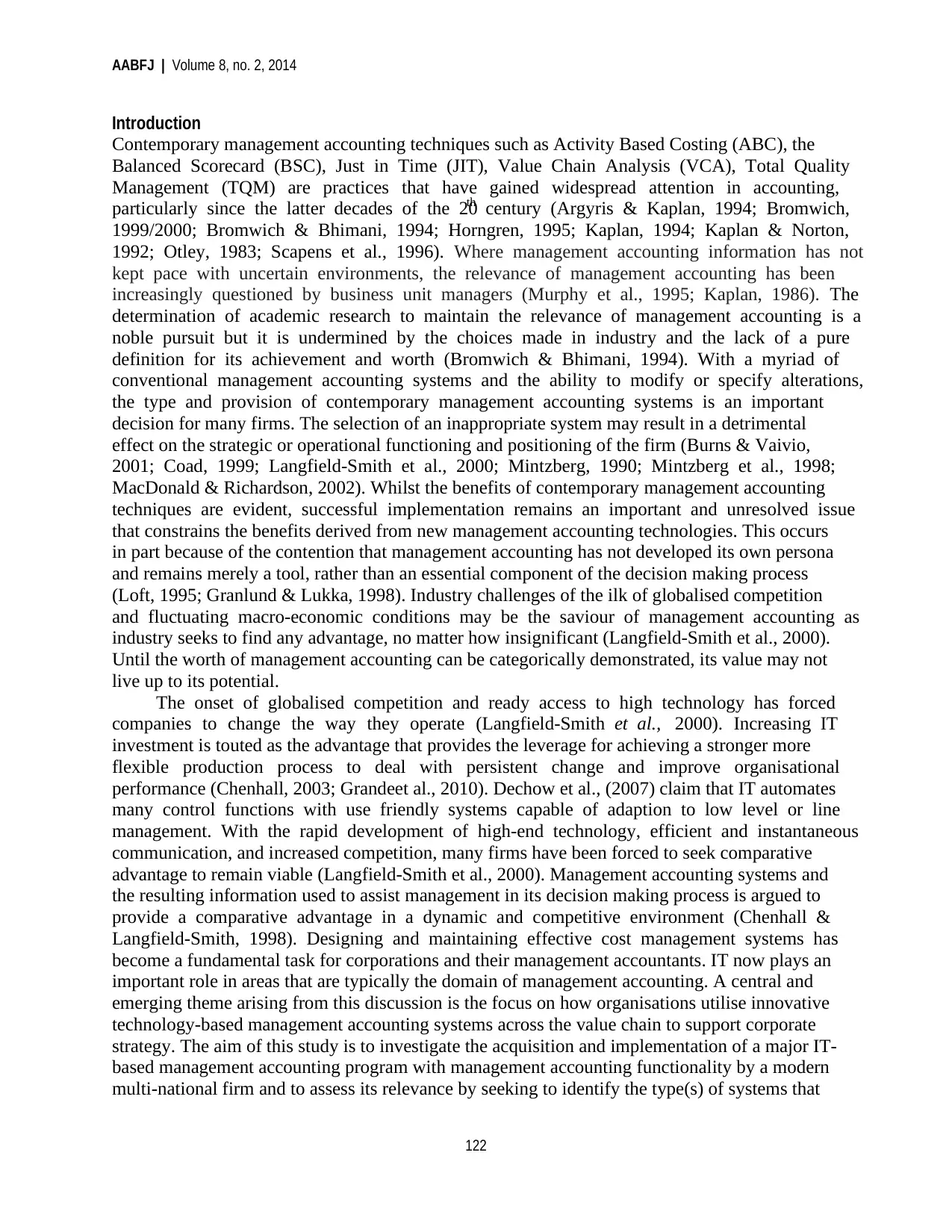
AABFJ | Volume 8, no. 2, 2014
122
Introduction
Contemporary management accounting techniques such as Activity Based Costing (ABC), the
Balanced Scorecard (BSC), Just in Time (JIT), Value Chain Analysis (VCA), Total Quality
Management (TQM) are practices that have gained widespread attention in accounting,
particularly since the latter decades of the 20th century (Argyris & Kaplan, 1994; Bromwich,
1999/2000; Bromwich & Bhimani, 1994; Horngren, 1995; Kaplan, 1994; Kaplan & Norton,
1992; Otley, 1983; Scapens et al., 1996). Where management accounting information has not
kept pace with uncertain environments, the relevance of management accounting has been
increasingly questioned by business unit managers (Murphy et al., 1995; Kaplan, 1986). The
determination of academic research to maintain the relevance of management accounting is a
noble pursuit but it is undermined by the choices made in industry and the lack of a pure
definition for its achievement and worth (Bromwich & Bhimani, 1994). With a myriad of
conventional management accounting systems and the ability to modify or specify alterations,
the type and provision of contemporary management accounting systems is an important
decision for many firms. The selection of an inappropriate system may result in a detrimental
effect on the strategic or operational functioning and positioning of the firm (Burns & Vaivio,
2001; Coad, 1999; Langfield-Smith et al., 2000; Mintzberg, 1990; Mintzberg et al., 1998;
MacDonald & Richardson, 2002). Whilst the benefits of contemporary management accounting
techniques are evident, successful implementation remains an important and unresolved issue
that constrains the benefits derived from new management accounting technologies. This occurs
in part because of the contention that management accounting has not developed its own persona
and remains merely a tool, rather than an essential component of the decision making process
(Loft, 1995; Granlund & Lukka, 1998). Industry challenges of the ilk of globalised competition
and fluctuating macro-economic conditions may be the saviour of management accounting as
industry seeks to find any advantage, no matter how insignificant (Langfield-Smith et al., 2000).
Until the worth of management accounting can be categorically demonstrated, its value may not
live up to its potential.
The onset of globalised competition and ready access to high technology has forced
companies to change the way they operate (Langfield-Smith et al., 2000). Increasing IT
investment is touted as the advantage that provides the leverage for achieving a stronger more
flexible production process to deal with persistent change and improve organisational
performance (Chenhall, 2003; Grandeet al., 2010). Dechow et al., (2007) claim that IT automates
many control functions with use friendly systems capable of adaption to low level or line
management. With the rapid development of high-end technology, efficient and instantaneous
communication, and increased competition, many firms have been forced to seek comparative
advantage to remain viable (Langfield-Smith et al., 2000). Management accounting systems and
the resulting information used to assist management in its decision making process is argued to
provide a comparative advantage in a dynamic and competitive environment (Chenhall &
Langfield-Smith, 1998). Designing and maintaining effective cost management systems has
become a fundamental task for corporations and their management accountants. IT now plays an
important role in areas that are typically the domain of management accounting. A central and
emerging theme arising from this discussion is the focus on how organisations utilise innovative
technology-based management accounting systems across the value chain to support corporate
strategy. The aim of this study is to investigate the acquisition and implementation of a major IT-
based management accounting program with management accounting functionality by a modern
multi-national firm and to assess its relevance by seeking to identify the type(s) of systems that
122
Introduction
Contemporary management accounting techniques such as Activity Based Costing (ABC), the
Balanced Scorecard (BSC), Just in Time (JIT), Value Chain Analysis (VCA), Total Quality
Management (TQM) are practices that have gained widespread attention in accounting,
particularly since the latter decades of the 20th century (Argyris & Kaplan, 1994; Bromwich,
1999/2000; Bromwich & Bhimani, 1994; Horngren, 1995; Kaplan, 1994; Kaplan & Norton,
1992; Otley, 1983; Scapens et al., 1996). Where management accounting information has not
kept pace with uncertain environments, the relevance of management accounting has been
increasingly questioned by business unit managers (Murphy et al., 1995; Kaplan, 1986). The
determination of academic research to maintain the relevance of management accounting is a
noble pursuit but it is undermined by the choices made in industry and the lack of a pure
definition for its achievement and worth (Bromwich & Bhimani, 1994). With a myriad of
conventional management accounting systems and the ability to modify or specify alterations,
the type and provision of contemporary management accounting systems is an important
decision for many firms. The selection of an inappropriate system may result in a detrimental
effect on the strategic or operational functioning and positioning of the firm (Burns & Vaivio,
2001; Coad, 1999; Langfield-Smith et al., 2000; Mintzberg, 1990; Mintzberg et al., 1998;
MacDonald & Richardson, 2002). Whilst the benefits of contemporary management accounting
techniques are evident, successful implementation remains an important and unresolved issue
that constrains the benefits derived from new management accounting technologies. This occurs
in part because of the contention that management accounting has not developed its own persona
and remains merely a tool, rather than an essential component of the decision making process
(Loft, 1995; Granlund & Lukka, 1998). Industry challenges of the ilk of globalised competition
and fluctuating macro-economic conditions may be the saviour of management accounting as
industry seeks to find any advantage, no matter how insignificant (Langfield-Smith et al., 2000).
Until the worth of management accounting can be categorically demonstrated, its value may not
live up to its potential.
The onset of globalised competition and ready access to high technology has forced
companies to change the way they operate (Langfield-Smith et al., 2000). Increasing IT
investment is touted as the advantage that provides the leverage for achieving a stronger more
flexible production process to deal with persistent change and improve organisational
performance (Chenhall, 2003; Grandeet al., 2010). Dechow et al., (2007) claim that IT automates
many control functions with use friendly systems capable of adaption to low level or line
management. With the rapid development of high-end technology, efficient and instantaneous
communication, and increased competition, many firms have been forced to seek comparative
advantage to remain viable (Langfield-Smith et al., 2000). Management accounting systems and
the resulting information used to assist management in its decision making process is argued to
provide a comparative advantage in a dynamic and competitive environment (Chenhall &
Langfield-Smith, 1998). Designing and maintaining effective cost management systems has
become a fundamental task for corporations and their management accountants. IT now plays an
important role in areas that are typically the domain of management accounting. A central and
emerging theme arising from this discussion is the focus on how organisations utilise innovative
technology-based management accounting systems across the value chain to support corporate
strategy. The aim of this study is to investigate the acquisition and implementation of a major IT-
based management accounting program with management accounting functionality by a modern
multi-national firm and to assess its relevance by seeking to identify the type(s) of systems that
Secure Best Marks with AI Grader
Need help grading? Try our AI Grader for instant feedback on your assignments.
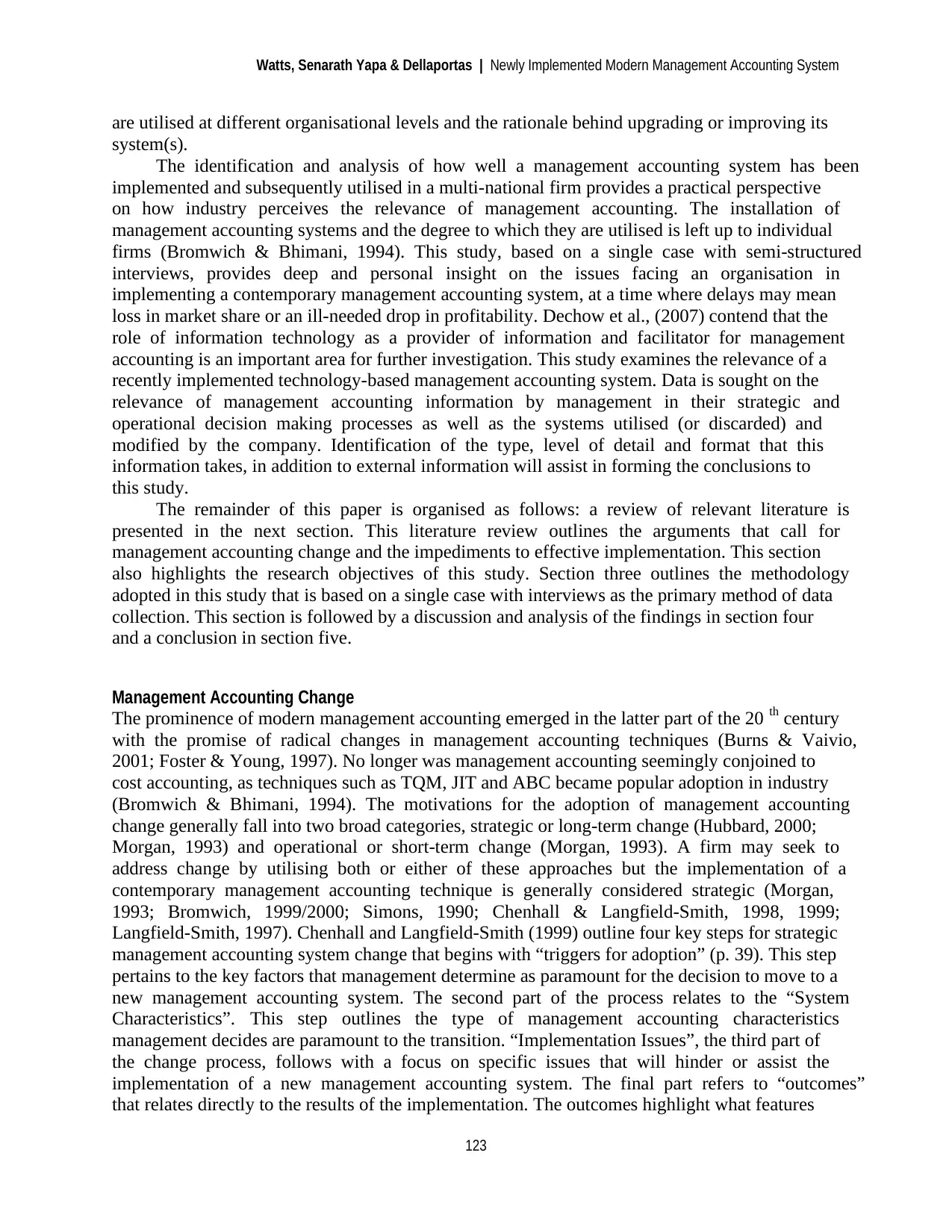
Watts, Senarath Yapa & Dellaportas | Newly Implemented Modern Management Accounting System
123
are utilised at different organisational levels and the rationale behind upgrading or improving its
system(s).
The identification and analysis of how well a management accounting system has been
implemented and subsequently utilised in a multi-national firm provides a practical perspective
on how industry perceives the relevance of management accounting. The installation of
management accounting systems and the degree to which they are utilised is left up to individual
firms (Bromwich & Bhimani, 1994). This study, based on a single case with semi-structured
interviews, provides deep and personal insight on the issues facing an organisation in
implementing a contemporary management accounting system, at a time where delays may mean
loss in market share or an ill-needed drop in profitability. Dechow et al., (2007) contend that the
role of information technology as a provider of information and facilitator for management
accounting is an important area for further investigation. This study examines the relevance of a
recently implemented technology-based management accounting system. Data is sought on the
relevance of management accounting information by management in their strategic and
operational decision making processes as well as the systems utilised (or discarded) and
modified by the company. Identification of the type, level of detail and format that this
information takes, in addition to external information will assist in forming the conclusions to
this study.
The remainder of this paper is organised as follows: a review of relevant literature is
presented in the next section. This literature review outlines the arguments that call for
management accounting change and the impediments to effective implementation. This section
also highlights the research objectives of this study. Section three outlines the methodology
adopted in this study that is based on a single case with interviews as the primary method of data
collection. This section is followed by a discussion and analysis of the findings in section four
and a conclusion in section five.
Management Accounting Change
The prominence of modern management accounting emerged in the latter part of the 20 th century
with the promise of radical changes in management accounting techniques (Burns & Vaivio,
2001; Foster & Young, 1997). No longer was management accounting seemingly conjoined to
cost accounting, as techniques such as TQM, JIT and ABC became popular adoption in industry
(Bromwich & Bhimani, 1994). The motivations for the adoption of management accounting
change generally fall into two broad categories, strategic or long-term change (Hubbard, 2000;
Morgan, 1993) and operational or short-term change (Morgan, 1993). A firm may seek to
address change by utilising both or either of these approaches but the implementation of a
contemporary management accounting technique is generally considered strategic (Morgan,
1993; Bromwich, 1999/2000; Simons, 1990; Chenhall & Langfield-Smith, 1998, 1999;
Langfield-Smith, 1997). Chenhall and Langfield-Smith (1999) outline four key steps for strategic
management accounting system change that begins with “triggers for adoption” (p. 39). This step
pertains to the key factors that management determine as paramount for the decision to move to a
new management accounting system. The second part of the process relates to the “System
Characteristics”. This step outlines the type of management accounting characteristics
management decides are paramount to the transition. “Implementation Issues”, the third part of
the change process, follows with a focus on specific issues that will hinder or assist the
implementation of a new management accounting system. The final part refers to “outcomes”
that relates directly to the results of the implementation. The outcomes highlight what features
123
are utilised at different organisational levels and the rationale behind upgrading or improving its
system(s).
The identification and analysis of how well a management accounting system has been
implemented and subsequently utilised in a multi-national firm provides a practical perspective
on how industry perceives the relevance of management accounting. The installation of
management accounting systems and the degree to which they are utilised is left up to individual
firms (Bromwich & Bhimani, 1994). This study, based on a single case with semi-structured
interviews, provides deep and personal insight on the issues facing an organisation in
implementing a contemporary management accounting system, at a time where delays may mean
loss in market share or an ill-needed drop in profitability. Dechow et al., (2007) contend that the
role of information technology as a provider of information and facilitator for management
accounting is an important area for further investigation. This study examines the relevance of a
recently implemented technology-based management accounting system. Data is sought on the
relevance of management accounting information by management in their strategic and
operational decision making processes as well as the systems utilised (or discarded) and
modified by the company. Identification of the type, level of detail and format that this
information takes, in addition to external information will assist in forming the conclusions to
this study.
The remainder of this paper is organised as follows: a review of relevant literature is
presented in the next section. This literature review outlines the arguments that call for
management accounting change and the impediments to effective implementation. This section
also highlights the research objectives of this study. Section three outlines the methodology
adopted in this study that is based on a single case with interviews as the primary method of data
collection. This section is followed by a discussion and analysis of the findings in section four
and a conclusion in section five.
Management Accounting Change
The prominence of modern management accounting emerged in the latter part of the 20 th century
with the promise of radical changes in management accounting techniques (Burns & Vaivio,
2001; Foster & Young, 1997). No longer was management accounting seemingly conjoined to
cost accounting, as techniques such as TQM, JIT and ABC became popular adoption in industry
(Bromwich & Bhimani, 1994). The motivations for the adoption of management accounting
change generally fall into two broad categories, strategic or long-term change (Hubbard, 2000;
Morgan, 1993) and operational or short-term change (Morgan, 1993). A firm may seek to
address change by utilising both or either of these approaches but the implementation of a
contemporary management accounting technique is generally considered strategic (Morgan,
1993; Bromwich, 1999/2000; Simons, 1990; Chenhall & Langfield-Smith, 1998, 1999;
Langfield-Smith, 1997). Chenhall and Langfield-Smith (1999) outline four key steps for strategic
management accounting system change that begins with “triggers for adoption” (p. 39). This step
pertains to the key factors that management determine as paramount for the decision to move to a
new management accounting system. The second part of the process relates to the “System
Characteristics”. This step outlines the type of management accounting characteristics
management decides are paramount to the transition. “Implementation Issues”, the third part of
the change process, follows with a focus on specific issues that will hinder or assist the
implementation of a new management accounting system. The final part refers to “outcomes”
that relates directly to the results of the implementation. The outcomes highlight what features
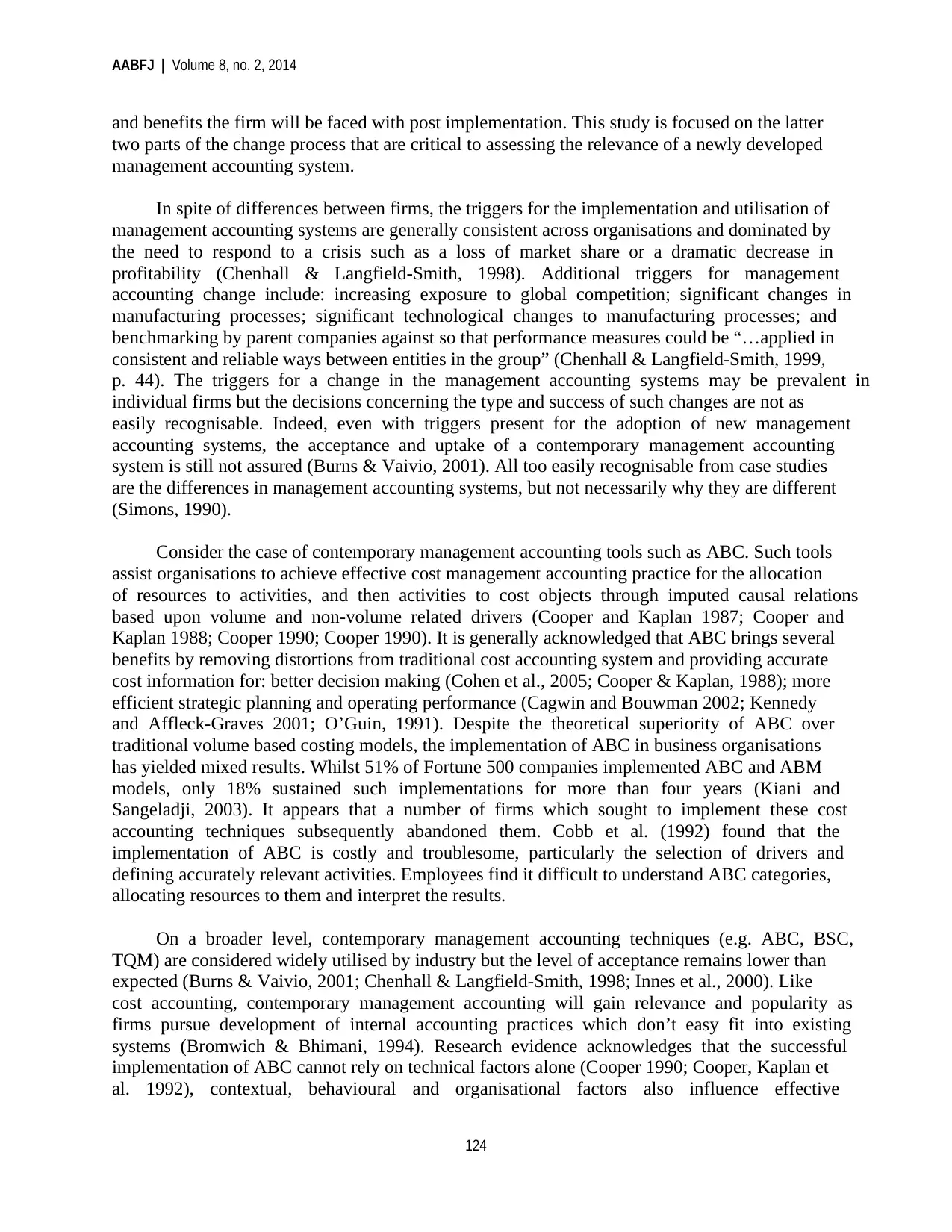
AABFJ | Volume 8, no. 2, 2014
124
and benefits the firm will be faced with post implementation. This study is focused on the latter
two parts of the change process that are critical to assessing the relevance of a newly developed
management accounting system.
In spite of differences between firms, the triggers for the implementation and utilisation of
management accounting systems are generally consistent across organisations and dominated by
the need to respond to a crisis such as a loss of market share or a dramatic decrease in
profitability (Chenhall & Langfield-Smith, 1998). Additional triggers for management
accounting change include: increasing exposure to global competition; significant changes in
manufacturing processes; significant technological changes to manufacturing processes; and
benchmarking by parent companies against so that performance measures could be “…applied in
consistent and reliable ways between entities in the group” (Chenhall & Langfield-Smith, 1999,
p. 44). The triggers for a change in the management accounting systems may be prevalent in
individual firms but the decisions concerning the type and success of such changes are not as
easily recognisable. Indeed, even with triggers present for the adoption of new management
accounting systems, the acceptance and uptake of a contemporary management accounting
system is still not assured (Burns & Vaivio, 2001). All too easily recognisable from case studies
are the differences in management accounting systems, but not necessarily why they are different
(Simons, 1990).
Consider the case of contemporary management accounting tools such as ABC. Such tools
assist organisations to achieve effective cost management accounting practice for the allocation
of resources to activities, and then activities to cost objects through imputed causal relations
based upon volume and non-volume related drivers (Cooper and Kaplan 1987; Cooper and
Kaplan 1988; Cooper 1990; Cooper 1990). It is generally acknowledged that ABC brings several
benefits by removing distortions from traditional cost accounting system and providing accurate
cost information for: better decision making (Cohen et al., 2005; Cooper & Kaplan, 1988); more
efficient strategic planning and operating performance (Cagwin and Bouwman 2002; Kennedy
and Affleck-Graves 2001; O’Guin, 1991). Despite the theoretical superiority of ABC over
traditional volume based costing models, the implementation of ABC in business organisations
has yielded mixed results. Whilst 51% of Fortune 500 companies implemented ABC and ABM
models, only 18% sustained such implementations for more than four years (Kiani and
Sangeladji, 2003). It appears that a number of firms which sought to implement these cost
accounting techniques subsequently abandoned them. Cobb et al. (1992) found that the
implementation of ABC is costly and troublesome, particularly the selection of drivers and
defining accurately relevant activities. Employees find it difficult to understand ABC categories,
allocating resources to them and interpret the results.
On a broader level, contemporary management accounting techniques (e.g. ABC, BSC,
TQM) are considered widely utilised by industry but the level of acceptance remains lower than
expected (Burns & Vaivio, 2001; Chenhall & Langfield-Smith, 1998; Innes et al., 2000). Like
cost accounting, contemporary management accounting will gain relevance and popularity as
firms pursue development of internal accounting practices which don’t easy fit into existing
systems (Bromwich & Bhimani, 1994). Research evidence acknowledges that the successful
implementation of ABC cannot rely on technical factors alone (Cooper 1990; Cooper, Kaplan et
al. 1992), contextual, behavioural and organisational factors also influence effective
124
and benefits the firm will be faced with post implementation. This study is focused on the latter
two parts of the change process that are critical to assessing the relevance of a newly developed
management accounting system.
In spite of differences between firms, the triggers for the implementation and utilisation of
management accounting systems are generally consistent across organisations and dominated by
the need to respond to a crisis such as a loss of market share or a dramatic decrease in
profitability (Chenhall & Langfield-Smith, 1998). Additional triggers for management
accounting change include: increasing exposure to global competition; significant changes in
manufacturing processes; significant technological changes to manufacturing processes; and
benchmarking by parent companies against so that performance measures could be “…applied in
consistent and reliable ways between entities in the group” (Chenhall & Langfield-Smith, 1999,
p. 44). The triggers for a change in the management accounting systems may be prevalent in
individual firms but the decisions concerning the type and success of such changes are not as
easily recognisable. Indeed, even with triggers present for the adoption of new management
accounting systems, the acceptance and uptake of a contemporary management accounting
system is still not assured (Burns & Vaivio, 2001). All too easily recognisable from case studies
are the differences in management accounting systems, but not necessarily why they are different
(Simons, 1990).
Consider the case of contemporary management accounting tools such as ABC. Such tools
assist organisations to achieve effective cost management accounting practice for the allocation
of resources to activities, and then activities to cost objects through imputed causal relations
based upon volume and non-volume related drivers (Cooper and Kaplan 1987; Cooper and
Kaplan 1988; Cooper 1990; Cooper 1990). It is generally acknowledged that ABC brings several
benefits by removing distortions from traditional cost accounting system and providing accurate
cost information for: better decision making (Cohen et al., 2005; Cooper & Kaplan, 1988); more
efficient strategic planning and operating performance (Cagwin and Bouwman 2002; Kennedy
and Affleck-Graves 2001; O’Guin, 1991). Despite the theoretical superiority of ABC over
traditional volume based costing models, the implementation of ABC in business organisations
has yielded mixed results. Whilst 51% of Fortune 500 companies implemented ABC and ABM
models, only 18% sustained such implementations for more than four years (Kiani and
Sangeladji, 2003). It appears that a number of firms which sought to implement these cost
accounting techniques subsequently abandoned them. Cobb et al. (1992) found that the
implementation of ABC is costly and troublesome, particularly the selection of drivers and
defining accurately relevant activities. Employees find it difficult to understand ABC categories,
allocating resources to them and interpret the results.
On a broader level, contemporary management accounting techniques (e.g. ABC, BSC,
TQM) are considered widely utilised by industry but the level of acceptance remains lower than
expected (Burns & Vaivio, 2001; Chenhall & Langfield-Smith, 1998; Innes et al., 2000). Like
cost accounting, contemporary management accounting will gain relevance and popularity as
firms pursue development of internal accounting practices which don’t easy fit into existing
systems (Bromwich & Bhimani, 1994). Research evidence acknowledges that the successful
implementation of ABC cannot rely on technical factors alone (Cooper 1990; Cooper, Kaplan et
al. 1992), contextual, behavioural and organisational factors also influence effective
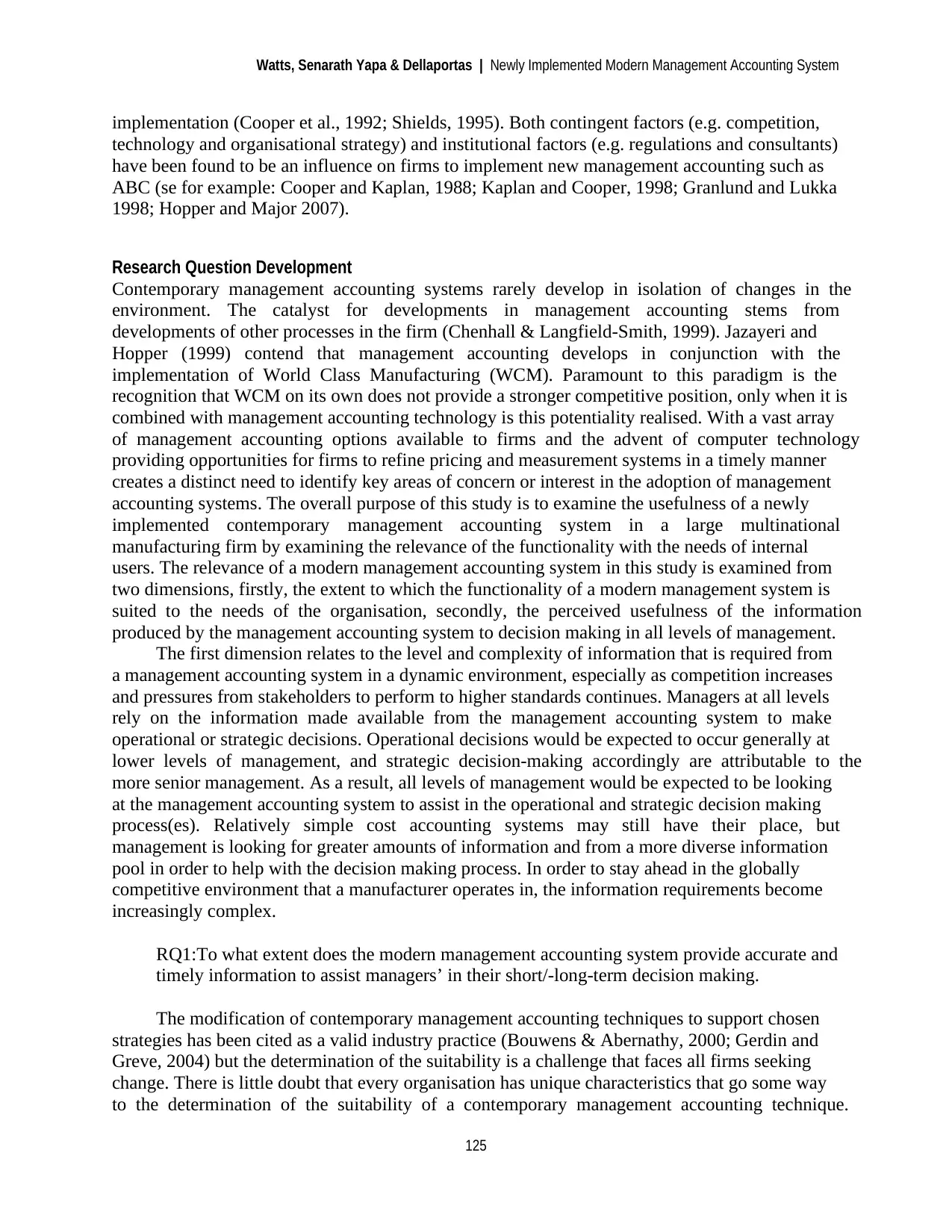
Watts, Senarath Yapa & Dellaportas | Newly Implemented Modern Management Accounting System
125
implementation (Cooper et al., 1992; Shields, 1995). Both contingent factors (e.g. competition,
technology and organisational strategy) and institutional factors (e.g. regulations and consultants)
have been found to be an influence on firms to implement new management accounting such as
ABC (se for example: Cooper and Kaplan, 1988; Kaplan and Cooper, 1998; Granlund and Lukka
1998; Hopper and Major 2007).
Research Question Development
Contemporary management accounting systems rarely develop in isolation of changes in the
environment. The catalyst for developments in management accounting stems from
developments of other processes in the firm (Chenhall & Langfield-Smith, 1999). Jazayeri and
Hopper (1999) contend that management accounting develops in conjunction with the
implementation of World Class Manufacturing (WCM). Paramount to this paradigm is the
recognition that WCM on its own does not provide a stronger competitive position, only when it is
combined with management accounting technology is this potentiality realised. With a vast array
of management accounting options available to firms and the advent of computer technology
providing opportunities for firms to refine pricing and measurement systems in a timely manner
creates a distinct need to identify key areas of concern or interest in the adoption of management
accounting systems. The overall purpose of this study is to examine the usefulness of a newly
implemented contemporary management accounting system in a large multinational
manufacturing firm by examining the relevance of the functionality with the needs of internal
users. The relevance of a modern management accounting system in this study is examined from
two dimensions, firstly, the extent to which the functionality of a modern management system is
suited to the needs of the organisation, secondly, the perceived usefulness of the information
produced by the management accounting system to decision making in all levels of management.
The first dimension relates to the level and complexity of information that is required from
a management accounting system in a dynamic environment, especially as competition increases
and pressures from stakeholders to perform to higher standards continues. Managers at all levels
rely on the information made available from the management accounting system to make
operational or strategic decisions. Operational decisions would be expected to occur generally at
lower levels of management, and strategic decision-making accordingly are attributable to the
more senior management. As a result, all levels of management would be expected to be looking
at the management accounting system to assist in the operational and strategic decision making
process(es). Relatively simple cost accounting systems may still have their place, but
management is looking for greater amounts of information and from a more diverse information
pool in order to help with the decision making process. In order to stay ahead in the globally
competitive environment that a manufacturer operates in, the information requirements become
increasingly complex.
RQ1:To what extent does the modern management accounting system provide accurate and
timely information to assist managers’ in their short/-long-term decision making.
The modification of contemporary management accounting techniques to support chosen
strategies has been cited as a valid industry practice (Bouwens & Abernathy, 2000; Gerdin and
Greve, 2004) but the determination of the suitability is a challenge that faces all firms seeking
change. There is little doubt that every organisation has unique characteristics that go some way
to the determination of the suitability of a contemporary management accounting technique.
125
implementation (Cooper et al., 1992; Shields, 1995). Both contingent factors (e.g. competition,
technology and organisational strategy) and institutional factors (e.g. regulations and consultants)
have been found to be an influence on firms to implement new management accounting such as
ABC (se for example: Cooper and Kaplan, 1988; Kaplan and Cooper, 1998; Granlund and Lukka
1998; Hopper and Major 2007).
Research Question Development
Contemporary management accounting systems rarely develop in isolation of changes in the
environment. The catalyst for developments in management accounting stems from
developments of other processes in the firm (Chenhall & Langfield-Smith, 1999). Jazayeri and
Hopper (1999) contend that management accounting develops in conjunction with the
implementation of World Class Manufacturing (WCM). Paramount to this paradigm is the
recognition that WCM on its own does not provide a stronger competitive position, only when it is
combined with management accounting technology is this potentiality realised. With a vast array
of management accounting options available to firms and the advent of computer technology
providing opportunities for firms to refine pricing and measurement systems in a timely manner
creates a distinct need to identify key areas of concern or interest in the adoption of management
accounting systems. The overall purpose of this study is to examine the usefulness of a newly
implemented contemporary management accounting system in a large multinational
manufacturing firm by examining the relevance of the functionality with the needs of internal
users. The relevance of a modern management accounting system in this study is examined from
two dimensions, firstly, the extent to which the functionality of a modern management system is
suited to the needs of the organisation, secondly, the perceived usefulness of the information
produced by the management accounting system to decision making in all levels of management.
The first dimension relates to the level and complexity of information that is required from
a management accounting system in a dynamic environment, especially as competition increases
and pressures from stakeholders to perform to higher standards continues. Managers at all levels
rely on the information made available from the management accounting system to make
operational or strategic decisions. Operational decisions would be expected to occur generally at
lower levels of management, and strategic decision-making accordingly are attributable to the
more senior management. As a result, all levels of management would be expected to be looking
at the management accounting system to assist in the operational and strategic decision making
process(es). Relatively simple cost accounting systems may still have their place, but
management is looking for greater amounts of information and from a more diverse information
pool in order to help with the decision making process. In order to stay ahead in the globally
competitive environment that a manufacturer operates in, the information requirements become
increasingly complex.
RQ1:To what extent does the modern management accounting system provide accurate and
timely information to assist managers’ in their short/-long-term decision making.
The modification of contemporary management accounting techniques to support chosen
strategies has been cited as a valid industry practice (Bouwens & Abernathy, 2000; Gerdin and
Greve, 2004) but the determination of the suitability is a challenge that faces all firms seeking
change. There is little doubt that every organisation has unique characteristics that go some way
to the determination of the suitability of a contemporary management accounting technique.
Paraphrase This Document
Need a fresh take? Get an instant paraphrase of this document with our AI Paraphraser
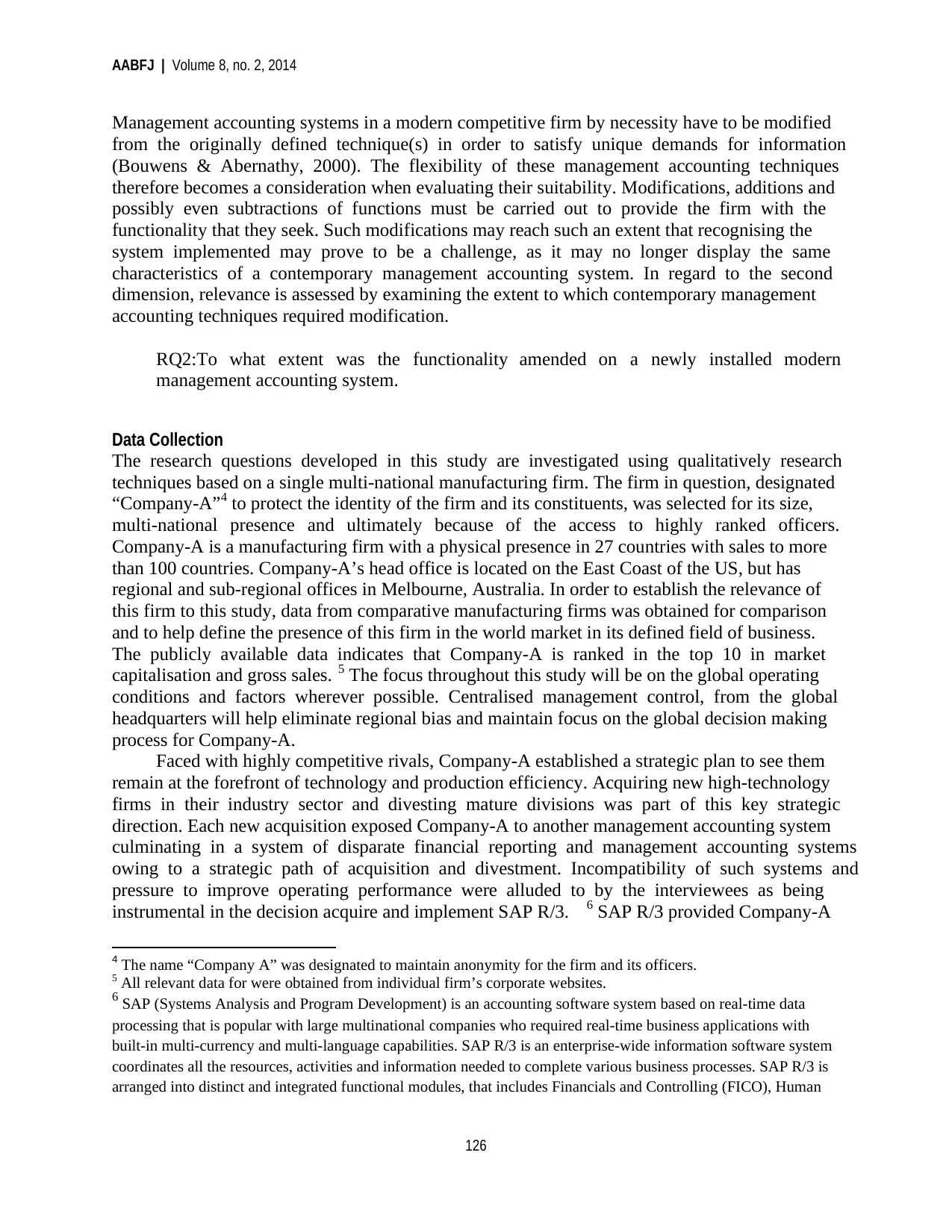
AABFJ | Volume 8, no. 2, 2014
126
Management accounting systems in a modern competitive firm by necessity have to be modified
from the originally defined technique(s) in order to satisfy unique demands for information
(Bouwens & Abernathy, 2000). The flexibility of these management accounting techniques
therefore becomes a consideration when evaluating their suitability. Modifications, additions and
possibly even subtractions of functions must be carried out to provide the firm with the
functionality that they seek. Such modifications may reach such an extent that recognising the
system implemented may prove to be a challenge, as it may no longer display the same
characteristics of a contemporary management accounting system. In regard to the second
dimension, relevance is assessed by examining the extent to which contemporary management
accounting techniques required modification.
RQ2:To what extent was the functionality amended on a newly installed modern
management accounting system.
Data Collection
The research questions developed in this study are investigated using qualitatively research
techniques based on a single multi-national manufacturing firm. The firm in question, designated
“Company-A”4 to protect the identity of the firm and its constituents, was selected for its size,
multi-national presence and ultimately because of the access to highly ranked officers.
Company-A is a manufacturing firm with a physical presence in 27 countries with sales to more
than 100 countries. Company-A’s head office is located on the East Coast of the US, but has
regional and sub-regional offices in Melbourne, Australia. In order to establish the relevance of
this firm to this study, data from comparative manufacturing firms was obtained for comparison
and to help define the presence of this firm in the world market in its defined field of business.
The publicly available data indicates that Company-A is ranked in the top 10 in market
capitalisation and gross sales. 5 The focus throughout this study will be on the global operating
conditions and factors wherever possible. Centralised management control, from the global
headquarters will help eliminate regional bias and maintain focus on the global decision making
process for Company-A.
Faced with highly competitive rivals, Company-A established a strategic plan to see them
remain at the forefront of technology and production efficiency. Acquiring new high-technology
firms in their industry sector and divesting mature divisions was part of this key strategic
direction. Each new acquisition exposed Company-A to another management accounting system
culminating in a system of disparate financial reporting and management accounting systems
owing to a strategic path of acquisition and divestment. Incompatibility of such systems and
pressure to improve operating performance were alluded to by the interviewees as being
instrumental in the decision acquire and implement SAP R/3. 6 SAP R/3 provided Company-A
4 The name “Company A” was designated to maintain anonymity for the firm and its officers.
5 All relevant data for were obtained from individual firm’s corporate websites.
6 SAP (Systems Analysis and Program Development) is an accounting software system based on real-time data
processing that is popular with large multinational companies who required real-time business applications with
built-in multi-currency and multi-language capabilities. SAP R/3 is an enterprise-wide information software system
coordinates all the resources, activities and information needed to complete various business processes. SAP R/3 is
arranged into distinct and integrated functional modules, that includes Financials and Controlling (FICO), Human
126
Management accounting systems in a modern competitive firm by necessity have to be modified
from the originally defined technique(s) in order to satisfy unique demands for information
(Bouwens & Abernathy, 2000). The flexibility of these management accounting techniques
therefore becomes a consideration when evaluating their suitability. Modifications, additions and
possibly even subtractions of functions must be carried out to provide the firm with the
functionality that they seek. Such modifications may reach such an extent that recognising the
system implemented may prove to be a challenge, as it may no longer display the same
characteristics of a contemporary management accounting system. In regard to the second
dimension, relevance is assessed by examining the extent to which contemporary management
accounting techniques required modification.
RQ2:To what extent was the functionality amended on a newly installed modern
management accounting system.
Data Collection
The research questions developed in this study are investigated using qualitatively research
techniques based on a single multi-national manufacturing firm. The firm in question, designated
“Company-A”4 to protect the identity of the firm and its constituents, was selected for its size,
multi-national presence and ultimately because of the access to highly ranked officers.
Company-A is a manufacturing firm with a physical presence in 27 countries with sales to more
than 100 countries. Company-A’s head office is located on the East Coast of the US, but has
regional and sub-regional offices in Melbourne, Australia. In order to establish the relevance of
this firm to this study, data from comparative manufacturing firms was obtained for comparison
and to help define the presence of this firm in the world market in its defined field of business.
The publicly available data indicates that Company-A is ranked in the top 10 in market
capitalisation and gross sales. 5 The focus throughout this study will be on the global operating
conditions and factors wherever possible. Centralised management control, from the global
headquarters will help eliminate regional bias and maintain focus on the global decision making
process for Company-A.
Faced with highly competitive rivals, Company-A established a strategic plan to see them
remain at the forefront of technology and production efficiency. Acquiring new high-technology
firms in their industry sector and divesting mature divisions was part of this key strategic
direction. Each new acquisition exposed Company-A to another management accounting system
culminating in a system of disparate financial reporting and management accounting systems
owing to a strategic path of acquisition and divestment. Incompatibility of such systems and
pressure to improve operating performance were alluded to by the interviewees as being
instrumental in the decision acquire and implement SAP R/3. 6 SAP R/3 provided Company-A
4 The name “Company A” was designated to maintain anonymity for the firm and its officers.
5 All relevant data for were obtained from individual firm’s corporate websites.
6 SAP (Systems Analysis and Program Development) is an accounting software system based on real-time data
processing that is popular with large multinational companies who required real-time business applications with
built-in multi-currency and multi-language capabilities. SAP R/3 is an enterprise-wide information software system
coordinates all the resources, activities and information needed to complete various business processes. SAP R/3 is
arranged into distinct and integrated functional modules, that includes Financials and Controlling (FICO), Human
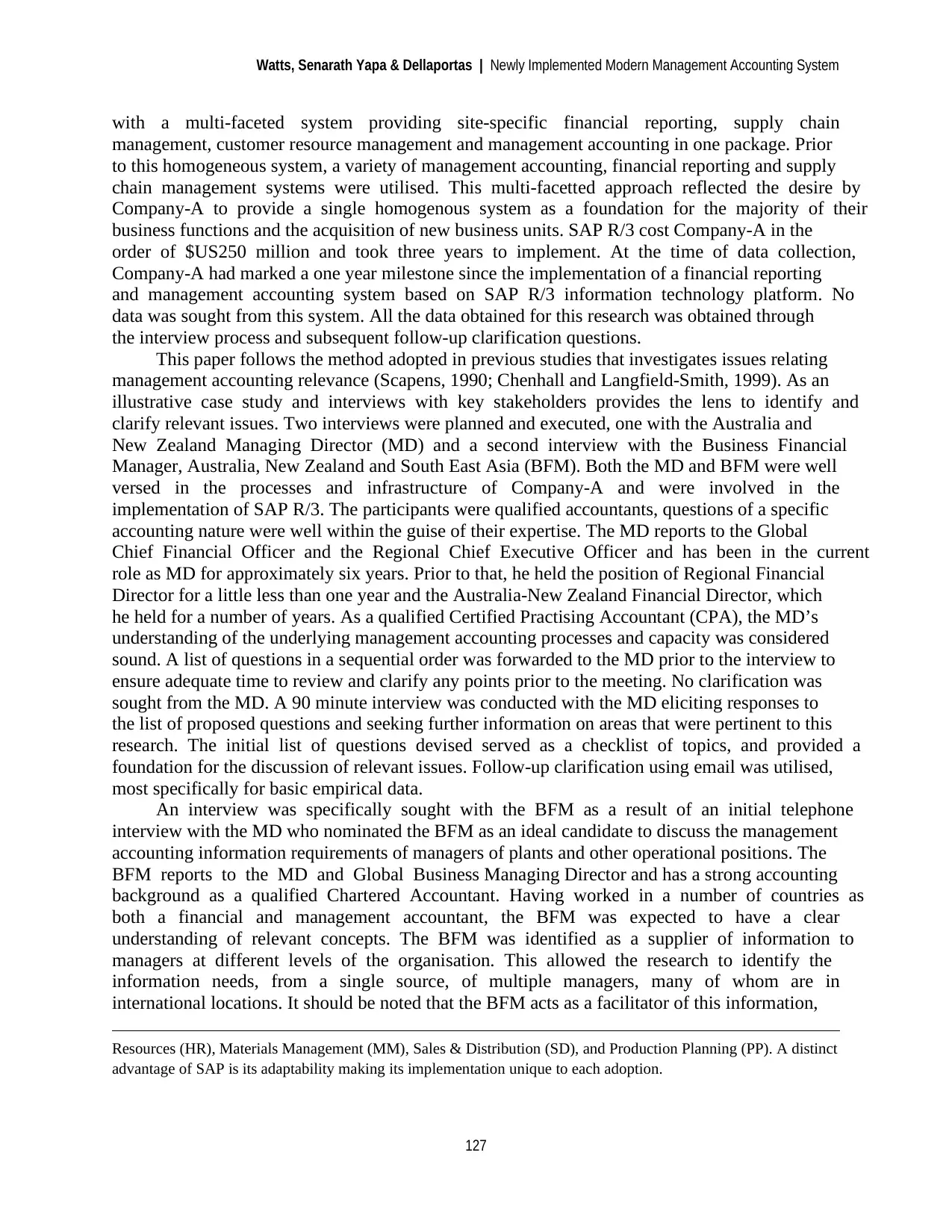
Watts, Senarath Yapa & Dellaportas | Newly Implemented Modern Management Accounting System
127
with a multi-faceted system providing site-specific financial reporting, supply chain
management, customer resource management and management accounting in one package. Prior
to this homogeneous system, a variety of management accounting, financial reporting and supply
chain management systems were utilised. This multi-facetted approach reflected the desire by
Company-A to provide a single homogenous system as a foundation for the majority of their
business functions and the acquisition of new business units. SAP R/3 cost Company-A in the
order of $US250 million and took three years to implement. At the time of data collection,
Company-A had marked a one year milestone since the implementation of a financial reporting
and management accounting system based on SAP R/3 information technology platform. No
data was sought from this system. All the data obtained for this research was obtained through
the interview process and subsequent follow-up clarification questions.
This paper follows the method adopted in previous studies that investigates issues relating
management accounting relevance (Scapens, 1990; Chenhall and Langfield-Smith, 1999). As an
illustrative case study and interviews with key stakeholders provides the lens to identify and
clarify relevant issues. Two interviews were planned and executed, one with the Australia and
New Zealand Managing Director (MD) and a second interview with the Business Financial
Manager, Australia, New Zealand and South East Asia (BFM). Both the MD and BFM were well
versed in the processes and infrastructure of Company-A and were involved in the
implementation of SAP R/3. The participants were qualified accountants, questions of a specific
accounting nature were well within the guise of their expertise. The MD reports to the Global
Chief Financial Officer and the Regional Chief Executive Officer and has been in the current
role as MD for approximately six years. Prior to that, he held the position of Regional Financial
Director for a little less than one year and the Australia-New Zealand Financial Director, which
he held for a number of years. As a qualified Certified Practising Accountant (CPA), the MD’s
understanding of the underlying management accounting processes and capacity was considered
sound. A list of questions in a sequential order was forwarded to the MD prior to the interview to
ensure adequate time to review and clarify any points prior to the meeting. No clarification was
sought from the MD. A 90 minute interview was conducted with the MD eliciting responses to
the list of proposed questions and seeking further information on areas that were pertinent to this
research. The initial list of questions devised served as a checklist of topics, and provided a
foundation for the discussion of relevant issues. Follow-up clarification using email was utilised,
most specifically for basic empirical data.
An interview was specifically sought with the BFM as a result of an initial telephone
interview with the MD who nominated the BFM as an ideal candidate to discuss the management
accounting information requirements of managers of plants and other operational positions. The
BFM reports to the MD and Global Business Managing Director and has a strong accounting
background as a qualified Chartered Accountant. Having worked in a number of countries as
both a financial and management accountant, the BFM was expected to have a clear
understanding of relevant concepts. The BFM was identified as a supplier of information to
managers at different levels of the organisation. This allowed the research to identify the
information needs, from a single source, of multiple managers, many of whom are in
international locations. It should be noted that the BFM acts as a facilitator of this information,
Resources (HR), Materials Management (MM), Sales & Distribution (SD), and Production Planning (PP). A distinct
advantage of SAP is its adaptability making its implementation unique to each adoption.
127
with a multi-faceted system providing site-specific financial reporting, supply chain
management, customer resource management and management accounting in one package. Prior
to this homogeneous system, a variety of management accounting, financial reporting and supply
chain management systems were utilised. This multi-facetted approach reflected the desire by
Company-A to provide a single homogenous system as a foundation for the majority of their
business functions and the acquisition of new business units. SAP R/3 cost Company-A in the
order of $US250 million and took three years to implement. At the time of data collection,
Company-A had marked a one year milestone since the implementation of a financial reporting
and management accounting system based on SAP R/3 information technology platform. No
data was sought from this system. All the data obtained for this research was obtained through
the interview process and subsequent follow-up clarification questions.
This paper follows the method adopted in previous studies that investigates issues relating
management accounting relevance (Scapens, 1990; Chenhall and Langfield-Smith, 1999). As an
illustrative case study and interviews with key stakeholders provides the lens to identify and
clarify relevant issues. Two interviews were planned and executed, one with the Australia and
New Zealand Managing Director (MD) and a second interview with the Business Financial
Manager, Australia, New Zealand and South East Asia (BFM). Both the MD and BFM were well
versed in the processes and infrastructure of Company-A and were involved in the
implementation of SAP R/3. The participants were qualified accountants, questions of a specific
accounting nature were well within the guise of their expertise. The MD reports to the Global
Chief Financial Officer and the Regional Chief Executive Officer and has been in the current
role as MD for approximately six years. Prior to that, he held the position of Regional Financial
Director for a little less than one year and the Australia-New Zealand Financial Director, which
he held for a number of years. As a qualified Certified Practising Accountant (CPA), the MD’s
understanding of the underlying management accounting processes and capacity was considered
sound. A list of questions in a sequential order was forwarded to the MD prior to the interview to
ensure adequate time to review and clarify any points prior to the meeting. No clarification was
sought from the MD. A 90 minute interview was conducted with the MD eliciting responses to
the list of proposed questions and seeking further information on areas that were pertinent to this
research. The initial list of questions devised served as a checklist of topics, and provided a
foundation for the discussion of relevant issues. Follow-up clarification using email was utilised,
most specifically for basic empirical data.
An interview was specifically sought with the BFM as a result of an initial telephone
interview with the MD who nominated the BFM as an ideal candidate to discuss the management
accounting information requirements of managers of plants and other operational positions. The
BFM reports to the MD and Global Business Managing Director and has a strong accounting
background as a qualified Chartered Accountant. Having worked in a number of countries as
both a financial and management accountant, the BFM was expected to have a clear
understanding of relevant concepts. The BFM was identified as a supplier of information to
managers at different levels of the organisation. This allowed the research to identify the
information needs, from a single source, of multiple managers, many of whom are in
international locations. It should be noted that the BFM acts as a facilitator of this information,
Resources (HR), Materials Management (MM), Sales & Distribution (SD), and Production Planning (PP). A distinct
advantage of SAP is its adaptability making its implementation unique to each adoption.
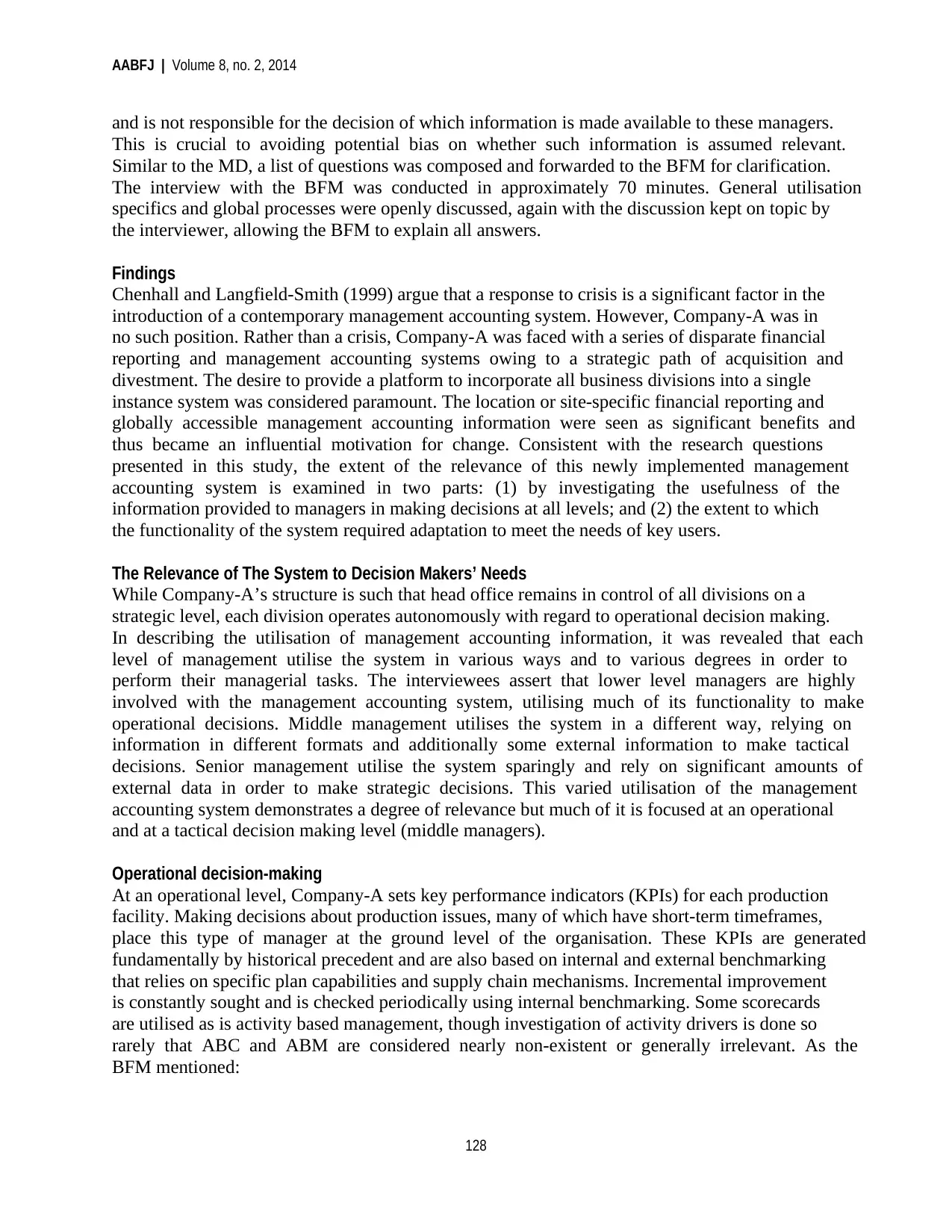
AABFJ | Volume 8, no. 2, 2014
128
and is not responsible for the decision of which information is made available to these managers.
This is crucial to avoiding potential bias on whether such information is assumed relevant.
Similar to the MD, a list of questions was composed and forwarded to the BFM for clarification.
The interview with the BFM was conducted in approximately 70 minutes. General utilisation
specifics and global processes were openly discussed, again with the discussion kept on topic by
the interviewer, allowing the BFM to explain all answers.
Findings
Chenhall and Langfield-Smith (1999) argue that a response to crisis is a significant factor in the
introduction of a contemporary management accounting system. However, Company-A was in
no such position. Rather than a crisis, Company-A was faced with a series of disparate financial
reporting and management accounting systems owing to a strategic path of acquisition and
divestment. The desire to provide a platform to incorporate all business divisions into a single
instance system was considered paramount. The location or site-specific financial reporting and
globally accessible management accounting information were seen as significant benefits and
thus became an influential motivation for change. Consistent with the research questions
presented in this study, the extent of the relevance of this newly implemented management
accounting system is examined in two parts: (1) by investigating the usefulness of the
information provided to managers in making decisions at all levels; and (2) the extent to which
the functionality of the system required adaptation to meet the needs of key users.
The Relevance of The System to Decision Makers’ Needs
While Company-A’s structure is such that head office remains in control of all divisions on a
strategic level, each division operates autonomously with regard to operational decision making.
In describing the utilisation of management accounting information, it was revealed that each
level of management utilise the system in various ways and to various degrees in order to
perform their managerial tasks. The interviewees assert that lower level managers are highly
involved with the management accounting system, utilising much of its functionality to make
operational decisions. Middle management utilises the system in a different way, relying on
information in different formats and additionally some external information to make tactical
decisions. Senior management utilise the system sparingly and rely on significant amounts of
external data in order to make strategic decisions. This varied utilisation of the management
accounting system demonstrates a degree of relevance but much of it is focused at an operational
and at a tactical decision making level (middle managers).
Operational decision-making
At an operational level, Company-A sets key performance indicators (KPIs) for each production
facility. Making decisions about production issues, many of which have short-term timeframes,
place this type of manager at the ground level of the organisation. These KPIs are generated
fundamentally by historical precedent and are also based on internal and external benchmarking
that relies on specific plan capabilities and supply chain mechanisms. Incremental improvement
is constantly sought and is checked periodically using internal benchmarking. Some scorecards
are utilised as is activity based management, though investigation of activity drivers is done so
rarely that ABC and ABM are considered nearly non-existent or generally irrelevant. As the
BFM mentioned:
128
and is not responsible for the decision of which information is made available to these managers.
This is crucial to avoiding potential bias on whether such information is assumed relevant.
Similar to the MD, a list of questions was composed and forwarded to the BFM for clarification.
The interview with the BFM was conducted in approximately 70 minutes. General utilisation
specifics and global processes were openly discussed, again with the discussion kept on topic by
the interviewer, allowing the BFM to explain all answers.
Findings
Chenhall and Langfield-Smith (1999) argue that a response to crisis is a significant factor in the
introduction of a contemporary management accounting system. However, Company-A was in
no such position. Rather than a crisis, Company-A was faced with a series of disparate financial
reporting and management accounting systems owing to a strategic path of acquisition and
divestment. The desire to provide a platform to incorporate all business divisions into a single
instance system was considered paramount. The location or site-specific financial reporting and
globally accessible management accounting information were seen as significant benefits and
thus became an influential motivation for change. Consistent with the research questions
presented in this study, the extent of the relevance of this newly implemented management
accounting system is examined in two parts: (1) by investigating the usefulness of the
information provided to managers in making decisions at all levels; and (2) the extent to which
the functionality of the system required adaptation to meet the needs of key users.
The Relevance of The System to Decision Makers’ Needs
While Company-A’s structure is such that head office remains in control of all divisions on a
strategic level, each division operates autonomously with regard to operational decision making.
In describing the utilisation of management accounting information, it was revealed that each
level of management utilise the system in various ways and to various degrees in order to
perform their managerial tasks. The interviewees assert that lower level managers are highly
involved with the management accounting system, utilising much of its functionality to make
operational decisions. Middle management utilises the system in a different way, relying on
information in different formats and additionally some external information to make tactical
decisions. Senior management utilise the system sparingly and rely on significant amounts of
external data in order to make strategic decisions. This varied utilisation of the management
accounting system demonstrates a degree of relevance but much of it is focused at an operational
and at a tactical decision making level (middle managers).
Operational decision-making
At an operational level, Company-A sets key performance indicators (KPIs) for each production
facility. Making decisions about production issues, many of which have short-term timeframes,
place this type of manager at the ground level of the organisation. These KPIs are generated
fundamentally by historical precedent and are also based on internal and external benchmarking
that relies on specific plan capabilities and supply chain mechanisms. Incremental improvement
is constantly sought and is checked periodically using internal benchmarking. Some scorecards
are utilised as is activity based management, though investigation of activity drivers is done so
rarely that ABC and ABM are considered nearly non-existent or generally irrelevant. As the
BFM mentioned:
Secure Best Marks with AI Grader
Need help grading? Try our AI Grader for instant feedback on your assignments.
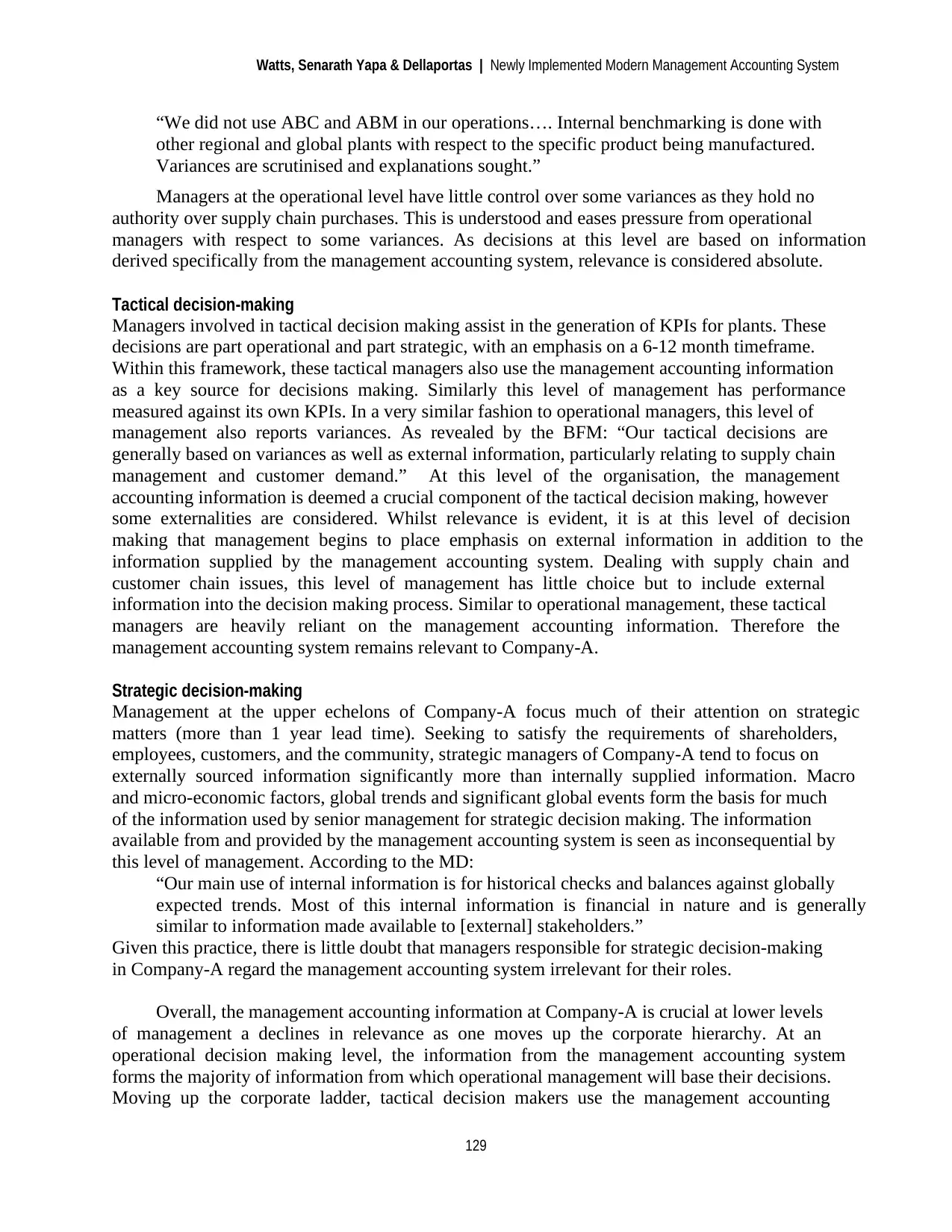
Watts, Senarath Yapa & Dellaportas | Newly Implemented Modern Management Accounting System
129
“We did not use ABC and ABM in our operations…. Internal benchmarking is done with
other regional and global plants with respect to the specific product being manufactured.
Variances are scrutinised and explanations sought.”
Managers at the operational level have little control over some variances as they hold no
authority over supply chain purchases. This is understood and eases pressure from operational
managers with respect to some variances. As decisions at this level are based on information
derived specifically from the management accounting system, relevance is considered absolute.
Tactical decision-making
Managers involved in tactical decision making assist in the generation of KPIs for plants. These
decisions are part operational and part strategic, with an emphasis on a 6-12 month timeframe.
Within this framework, these tactical managers also use the management accounting information
as a key source for decisions making. Similarly this level of management has performance
measured against its own KPIs. In a very similar fashion to operational managers, this level of
management also reports variances. As revealed by the BFM: “Our tactical decisions are
generally based on variances as well as external information, particularly relating to supply chain
management and customer demand.” At this level of the organisation, the management
accounting information is deemed a crucial component of the tactical decision making, however
some externalities are considered. Whilst relevance is evident, it is at this level of decision
making that management begins to place emphasis on external information in addition to the
information supplied by the management accounting system. Dealing with supply chain and
customer chain issues, this level of management has little choice but to include external
information into the decision making process. Similar to operational management, these tactical
managers are heavily reliant on the management accounting information. Therefore the
management accounting system remains relevant to Company-A.
Strategic decision-making
Management at the upper echelons of Company-A focus much of their attention on strategic
matters (more than 1 year lead time). Seeking to satisfy the requirements of shareholders,
employees, customers, and the community, strategic managers of Company-A tend to focus on
externally sourced information significantly more than internally supplied information. Macro
and micro-economic factors, global trends and significant global events form the basis for much
of the information used by senior management for strategic decision making. The information
available from and provided by the management accounting system is seen as inconsequential by
this level of management. According to the MD:
“Our main use of internal information is for historical checks and balances against globally
expected trends. Most of this internal information is financial in nature and is generally
similar to information made available to [external] stakeholders.”
Given this practice, there is little doubt that managers responsible for strategic decision-making
in Company-A regard the management accounting system irrelevant for their roles.
Overall, the management accounting information at Company-A is crucial at lower levels
of management a declines in relevance as one moves up the corporate hierarchy. At an
operational decision making level, the information from the management accounting system
forms the majority of information from which operational management will base their decisions.
Moving up the corporate ladder, tactical decision makers use the management accounting
129
“We did not use ABC and ABM in our operations…. Internal benchmarking is done with
other regional and global plants with respect to the specific product being manufactured.
Variances are scrutinised and explanations sought.”
Managers at the operational level have little control over some variances as they hold no
authority over supply chain purchases. This is understood and eases pressure from operational
managers with respect to some variances. As decisions at this level are based on information
derived specifically from the management accounting system, relevance is considered absolute.
Tactical decision-making
Managers involved in tactical decision making assist in the generation of KPIs for plants. These
decisions are part operational and part strategic, with an emphasis on a 6-12 month timeframe.
Within this framework, these tactical managers also use the management accounting information
as a key source for decisions making. Similarly this level of management has performance
measured against its own KPIs. In a very similar fashion to operational managers, this level of
management also reports variances. As revealed by the BFM: “Our tactical decisions are
generally based on variances as well as external information, particularly relating to supply chain
management and customer demand.” At this level of the organisation, the management
accounting information is deemed a crucial component of the tactical decision making, however
some externalities are considered. Whilst relevance is evident, it is at this level of decision
making that management begins to place emphasis on external information in addition to the
information supplied by the management accounting system. Dealing with supply chain and
customer chain issues, this level of management has little choice but to include external
information into the decision making process. Similar to operational management, these tactical
managers are heavily reliant on the management accounting information. Therefore the
management accounting system remains relevant to Company-A.
Strategic decision-making
Management at the upper echelons of Company-A focus much of their attention on strategic
matters (more than 1 year lead time). Seeking to satisfy the requirements of shareholders,
employees, customers, and the community, strategic managers of Company-A tend to focus on
externally sourced information significantly more than internally supplied information. Macro
and micro-economic factors, global trends and significant global events form the basis for much
of the information used by senior management for strategic decision making. The information
available from and provided by the management accounting system is seen as inconsequential by
this level of management. According to the MD:
“Our main use of internal information is for historical checks and balances against globally
expected trends. Most of this internal information is financial in nature and is generally
similar to information made available to [external] stakeholders.”
Given this practice, there is little doubt that managers responsible for strategic decision-making
in Company-A regard the management accounting system irrelevant for their roles.
Overall, the management accounting information at Company-A is crucial at lower levels
of management a declines in relevance as one moves up the corporate hierarchy. At an
operational decision making level, the information from the management accounting system
forms the majority of information from which operational management will base their decisions.
Moving up the corporate ladder, tactical decision makers use the management accounting
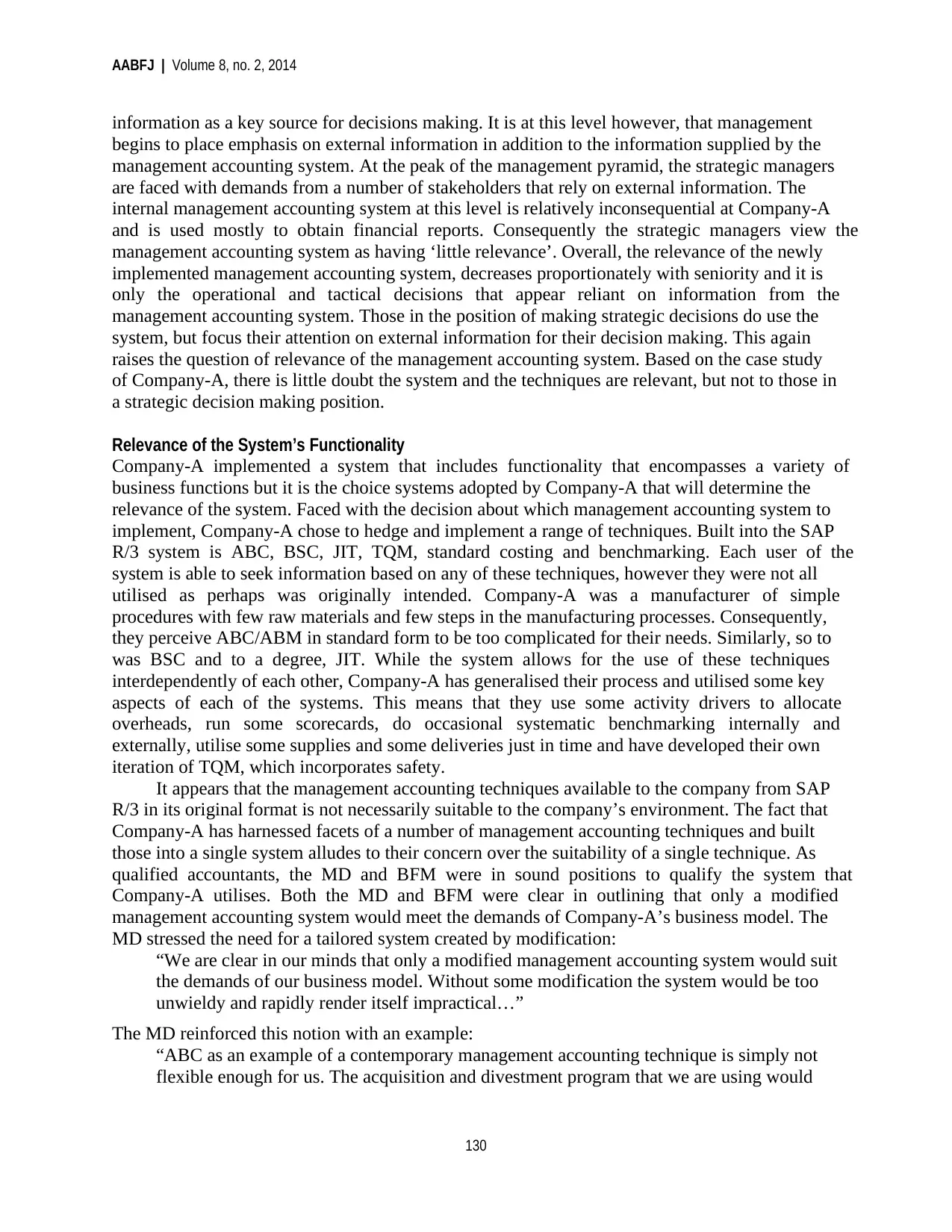
AABFJ | Volume 8, no. 2, 2014
130
information as a key source for decisions making. It is at this level however, that management
begins to place emphasis on external information in addition to the information supplied by the
management accounting system. At the peak of the management pyramid, the strategic managers
are faced with demands from a number of stakeholders that rely on external information. The
internal management accounting system at this level is relatively inconsequential at Company-A
and is used mostly to obtain financial reports. Consequently the strategic managers view the
management accounting system as having ‘little relevance’. Overall, the relevance of the newly
implemented management accounting system, decreases proportionately with seniority and it is
only the operational and tactical decisions that appear reliant on information from the
management accounting system. Those in the position of making strategic decisions do use the
system, but focus their attention on external information for their decision making. This again
raises the question of relevance of the management accounting system. Based on the case study
of Company-A, there is little doubt the system and the techniques are relevant, but not to those in
a strategic decision making position.
Relevance of the System’s Functionality
Company-A implemented a system that includes functionality that encompasses a variety of
business functions but it is the choice systems adopted by Company-A that will determine the
relevance of the system. Faced with the decision about which management accounting system to
implement, Company-A chose to hedge and implement a range of techniques. Built into the SAP
R/3 system is ABC, BSC, JIT, TQM, standard costing and benchmarking. Each user of the
system is able to seek information based on any of these techniques, however they were not all
utilised as perhaps was originally intended. Company-A was a manufacturer of simple
procedures with few raw materials and few steps in the manufacturing processes. Consequently,
they perceive ABC/ABM in standard form to be too complicated for their needs. Similarly, so to
was BSC and to a degree, JIT. While the system allows for the use of these techniques
interdependently of each other, Company-A has generalised their process and utilised some key
aspects of each of the systems. This means that they use some activity drivers to allocate
overheads, run some scorecards, do occasional systematic benchmarking internally and
externally, utilise some supplies and some deliveries just in time and have developed their own
iteration of TQM, which incorporates safety.
It appears that the management accounting techniques available to the company from SAP
R/3 in its original format is not necessarily suitable to the company’s environment. The fact that
Company-A has harnessed facets of a number of management accounting techniques and built
those into a single system alludes to their concern over the suitability of a single technique. As
qualified accountants, the MD and BFM were in sound positions to qualify the system that
Company-A utilises. Both the MD and BFM were clear in outlining that only a modified
management accounting system would meet the demands of Company-A’s business model. The
MD stressed the need for a tailored system created by modification:
“We are clear in our minds that only a modified management accounting system would suit
the demands of our business model. Without some modification the system would be too
unwieldy and rapidly render itself impractical…”
The MD reinforced this notion with an example:
“ABC as an example of a contemporary management accounting technique is simply not
flexible enough for us. The acquisition and divestment program that we are using would
130
information as a key source for decisions making. It is at this level however, that management
begins to place emphasis on external information in addition to the information supplied by the
management accounting system. At the peak of the management pyramid, the strategic managers
are faced with demands from a number of stakeholders that rely on external information. The
internal management accounting system at this level is relatively inconsequential at Company-A
and is used mostly to obtain financial reports. Consequently the strategic managers view the
management accounting system as having ‘little relevance’. Overall, the relevance of the newly
implemented management accounting system, decreases proportionately with seniority and it is
only the operational and tactical decisions that appear reliant on information from the
management accounting system. Those in the position of making strategic decisions do use the
system, but focus their attention on external information for their decision making. This again
raises the question of relevance of the management accounting system. Based on the case study
of Company-A, there is little doubt the system and the techniques are relevant, but not to those in
a strategic decision making position.
Relevance of the System’s Functionality
Company-A implemented a system that includes functionality that encompasses a variety of
business functions but it is the choice systems adopted by Company-A that will determine the
relevance of the system. Faced with the decision about which management accounting system to
implement, Company-A chose to hedge and implement a range of techniques. Built into the SAP
R/3 system is ABC, BSC, JIT, TQM, standard costing and benchmarking. Each user of the
system is able to seek information based on any of these techniques, however they were not all
utilised as perhaps was originally intended. Company-A was a manufacturer of simple
procedures with few raw materials and few steps in the manufacturing processes. Consequently,
they perceive ABC/ABM in standard form to be too complicated for their needs. Similarly, so to
was BSC and to a degree, JIT. While the system allows for the use of these techniques
interdependently of each other, Company-A has generalised their process and utilised some key
aspects of each of the systems. This means that they use some activity drivers to allocate
overheads, run some scorecards, do occasional systematic benchmarking internally and
externally, utilise some supplies and some deliveries just in time and have developed their own
iteration of TQM, which incorporates safety.
It appears that the management accounting techniques available to the company from SAP
R/3 in its original format is not necessarily suitable to the company’s environment. The fact that
Company-A has harnessed facets of a number of management accounting techniques and built
those into a single system alludes to their concern over the suitability of a single technique. As
qualified accountants, the MD and BFM were in sound positions to qualify the system that
Company-A utilises. Both the MD and BFM were clear in outlining that only a modified
management accounting system would meet the demands of Company-A’s business model. The
MD stressed the need for a tailored system created by modification:
“We are clear in our minds that only a modified management accounting system would suit
the demands of our business model. Without some modification the system would be too
unwieldy and rapidly render itself impractical…”
The MD reinforced this notion with an example:
“ABC as an example of a contemporary management accounting technique is simply not
flexible enough for us. The acquisition and divestment program that we are using would
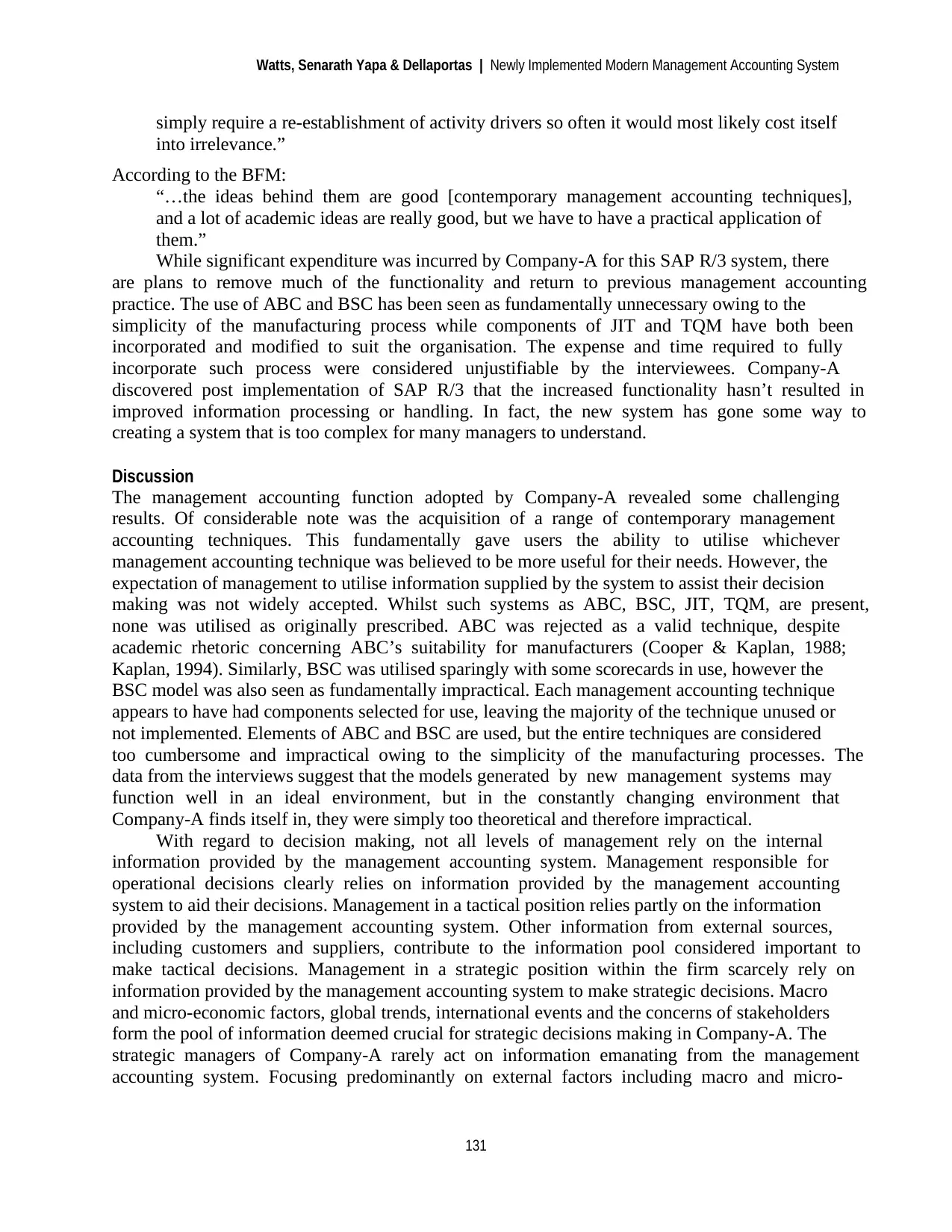
Watts, Senarath Yapa & Dellaportas | Newly Implemented Modern Management Accounting System
131
simply require a re-establishment of activity drivers so often it would most likely cost itself
into irrelevance.”
According to the BFM:
“…the ideas behind them are good [contemporary management accounting techniques],
and a lot of academic ideas are really good, but we have to have a practical application of
them.”
While significant expenditure was incurred by Company-A for this SAP R/3 system, there
are plans to remove much of the functionality and return to previous management accounting
practice. The use of ABC and BSC has been seen as fundamentally unnecessary owing to the
simplicity of the manufacturing process while components of JIT and TQM have both been
incorporated and modified to suit the organisation. The expense and time required to fully
incorporate such process were considered unjustifiable by the interviewees. Company-A
discovered post implementation of SAP R/3 that the increased functionality hasn’t resulted in
improved information processing or handling. In fact, the new system has gone some way to
creating a system that is too complex for many managers to understand.
Discussion
The management accounting function adopted by Company-A revealed some challenging
results. Of considerable note was the acquisition of a range of contemporary management
accounting techniques. This fundamentally gave users the ability to utilise whichever
management accounting technique was believed to be more useful for their needs. However, the
expectation of management to utilise information supplied by the system to assist their decision
making was not widely accepted. Whilst such systems as ABC, BSC, JIT, TQM, are present,
none was utilised as originally prescribed. ABC was rejected as a valid technique, despite
academic rhetoric concerning ABC’s suitability for manufacturers (Cooper & Kaplan, 1988;
Kaplan, 1994). Similarly, BSC was utilised sparingly with some scorecards in use, however the
BSC model was also seen as fundamentally impractical. Each management accounting technique
appears to have had components selected for use, leaving the majority of the technique unused or
not implemented. Elements of ABC and BSC are used, but the entire techniques are considered
too cumbersome and impractical owing to the simplicity of the manufacturing processes. The
data from the interviews suggest that the models generated by new management systems may
function well in an ideal environment, but in the constantly changing environment that
Company-A finds itself in, they were simply too theoretical and therefore impractical.
With regard to decision making, not all levels of management rely on the internal
information provided by the management accounting system. Management responsible for
operational decisions clearly relies on information provided by the management accounting
system to aid their decisions. Management in a tactical position relies partly on the information
provided by the management accounting system. Other information from external sources,
including customers and suppliers, contribute to the information pool considered important to
make tactical decisions. Management in a strategic position within the firm scarcely rely on
information provided by the management accounting system to make strategic decisions. Macro
and micro-economic factors, global trends, international events and the concerns of stakeholders
form the pool of information deemed crucial for strategic decisions making in Company-A. The
strategic managers of Company-A rarely act on information emanating from the management
accounting system. Focusing predominantly on external factors including macro and micro-
131
simply require a re-establishment of activity drivers so often it would most likely cost itself
into irrelevance.”
According to the BFM:
“…the ideas behind them are good [contemporary management accounting techniques],
and a lot of academic ideas are really good, but we have to have a practical application of
them.”
While significant expenditure was incurred by Company-A for this SAP R/3 system, there
are plans to remove much of the functionality and return to previous management accounting
practice. The use of ABC and BSC has been seen as fundamentally unnecessary owing to the
simplicity of the manufacturing process while components of JIT and TQM have both been
incorporated and modified to suit the organisation. The expense and time required to fully
incorporate such process were considered unjustifiable by the interviewees. Company-A
discovered post implementation of SAP R/3 that the increased functionality hasn’t resulted in
improved information processing or handling. In fact, the new system has gone some way to
creating a system that is too complex for many managers to understand.
Discussion
The management accounting function adopted by Company-A revealed some challenging
results. Of considerable note was the acquisition of a range of contemporary management
accounting techniques. This fundamentally gave users the ability to utilise whichever
management accounting technique was believed to be more useful for their needs. However, the
expectation of management to utilise information supplied by the system to assist their decision
making was not widely accepted. Whilst such systems as ABC, BSC, JIT, TQM, are present,
none was utilised as originally prescribed. ABC was rejected as a valid technique, despite
academic rhetoric concerning ABC’s suitability for manufacturers (Cooper & Kaplan, 1988;
Kaplan, 1994). Similarly, BSC was utilised sparingly with some scorecards in use, however the
BSC model was also seen as fundamentally impractical. Each management accounting technique
appears to have had components selected for use, leaving the majority of the technique unused or
not implemented. Elements of ABC and BSC are used, but the entire techniques are considered
too cumbersome and impractical owing to the simplicity of the manufacturing processes. The
data from the interviews suggest that the models generated by new management systems may
function well in an ideal environment, but in the constantly changing environment that
Company-A finds itself in, they were simply too theoretical and therefore impractical.
With regard to decision making, not all levels of management rely on the internal
information provided by the management accounting system. Management responsible for
operational decisions clearly relies on information provided by the management accounting
system to aid their decisions. Management in a tactical position relies partly on the information
provided by the management accounting system. Other information from external sources,
including customers and suppliers, contribute to the information pool considered important to
make tactical decisions. Management in a strategic position within the firm scarcely rely on
information provided by the management accounting system to make strategic decisions. Macro
and micro-economic factors, global trends, international events and the concerns of stakeholders
form the pool of information deemed crucial for strategic decisions making in Company-A. The
strategic managers of Company-A rarely act on information emanating from the management
accounting system. Focusing predominantly on external factors including macro and micro-
Paraphrase This Document
Need a fresh take? Get an instant paraphrase of this document with our AI Paraphraser
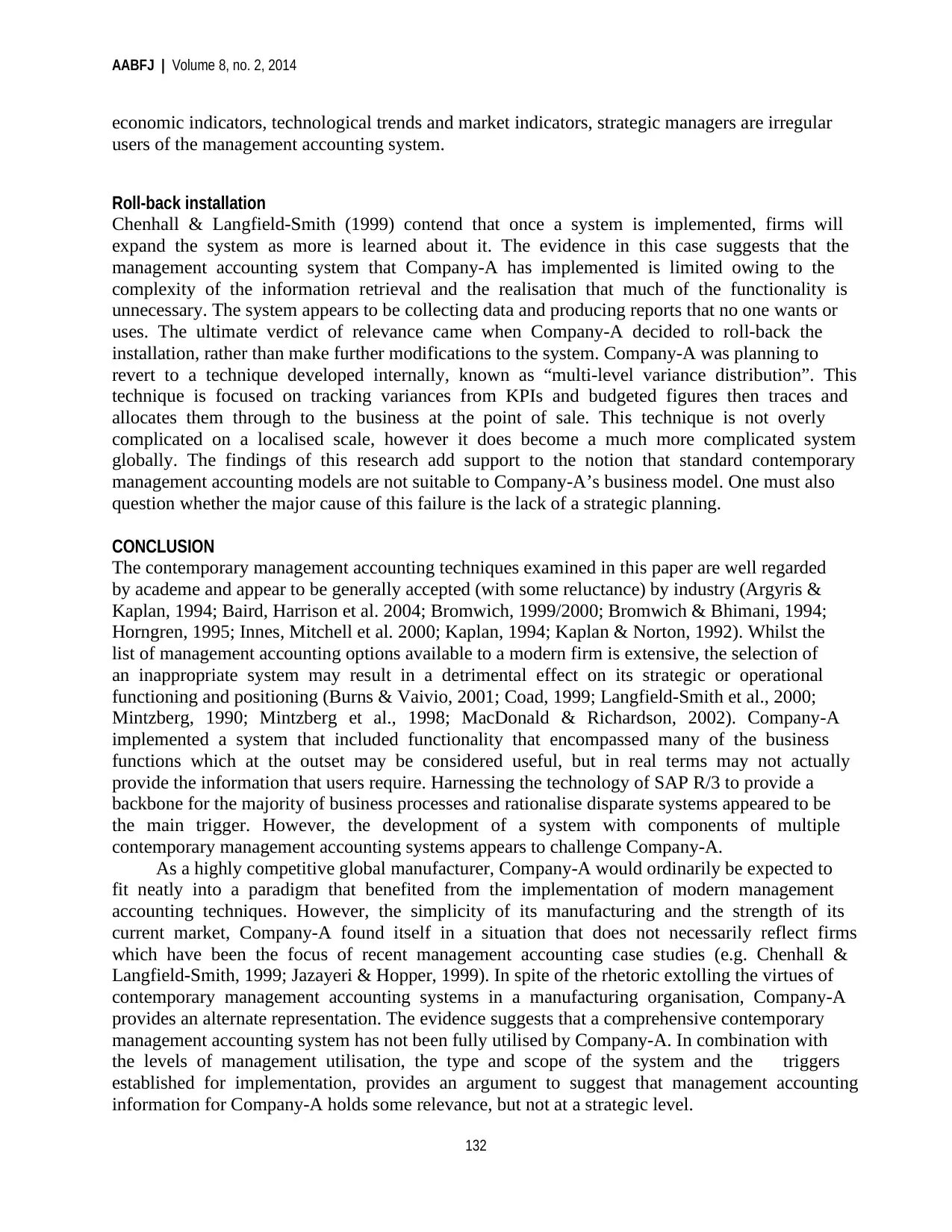
AABFJ | Volume 8, no. 2, 2014
132
economic indicators, technological trends and market indicators, strategic managers are irregular
users of the management accounting system.
Roll-back installation
Chenhall & Langfield-Smith (1999) contend that once a system is implemented, firms will
expand the system as more is learned about it. The evidence in this case suggests that the
management accounting system that Company-A has implemented is limited owing to the
complexity of the information retrieval and the realisation that much of the functionality is
unnecessary. The system appears to be collecting data and producing reports that no one wants or
uses. The ultimate verdict of relevance came when Company-A decided to roll-back the
installation, rather than make further modifications to the system. Company-A was planning to
revert to a technique developed internally, known as “multi-level variance distribution”. This
technique is focused on tracking variances from KPIs and budgeted figures then traces and
allocates them through to the business at the point of sale. This technique is not overly
complicated on a localised scale, however it does become a much more complicated system
globally. The findings of this research add support to the notion that standard contemporary
management accounting models are not suitable to Company-A’s business model. One must also
question whether the major cause of this failure is the lack of a strategic planning.
CONCLUSION
The contemporary management accounting techniques examined in this paper are well regarded
by academe and appear to be generally accepted (with some reluctance) by industry (Argyris &
Kaplan, 1994; Baird, Harrison et al. 2004; Bromwich, 1999/2000; Bromwich & Bhimani, 1994;
Horngren, 1995; Innes, Mitchell et al. 2000; Kaplan, 1994; Kaplan & Norton, 1992). Whilst the
list of management accounting options available to a modern firm is extensive, the selection of
an inappropriate system may result in a detrimental effect on its strategic or operational
functioning and positioning (Burns & Vaivio, 2001; Coad, 1999; Langfield-Smith et al., 2000;
Mintzberg, 1990; Mintzberg et al., 1998; MacDonald & Richardson, 2002). Company-A
implemented a system that included functionality that encompassed many of the business
functions which at the outset may be considered useful, but in real terms may not actually
provide the information that users require. Harnessing the technology of SAP R/3 to provide a
backbone for the majority of business processes and rationalise disparate systems appeared to be
the main trigger. However, the development of a system with components of multiple
contemporary management accounting systems appears to challenge Company-A.
As a highly competitive global manufacturer, Company-A would ordinarily be expected to
fit neatly into a paradigm that benefited from the implementation of modern management
accounting techniques. However, the simplicity of its manufacturing and the strength of its
current market, Company-A found itself in a situation that does not necessarily reflect firms
which have been the focus of recent management accounting case studies (e.g. Chenhall &
Langfield-Smith, 1999; Jazayeri & Hopper, 1999). In spite of the rhetoric extolling the virtues of
contemporary management accounting systems in a manufacturing organisation, Company-A
provides an alternate representation. The evidence suggests that a comprehensive contemporary
management accounting system has not been fully utilised by Company-A. In combination with
the levels of management utilisation, the type and scope of the system and the triggers
established for implementation, provides an argument to suggest that management accounting
information for Company-A holds some relevance, but not at a strategic level.
132
economic indicators, technological trends and market indicators, strategic managers are irregular
users of the management accounting system.
Roll-back installation
Chenhall & Langfield-Smith (1999) contend that once a system is implemented, firms will
expand the system as more is learned about it. The evidence in this case suggests that the
management accounting system that Company-A has implemented is limited owing to the
complexity of the information retrieval and the realisation that much of the functionality is
unnecessary. The system appears to be collecting data and producing reports that no one wants or
uses. The ultimate verdict of relevance came when Company-A decided to roll-back the
installation, rather than make further modifications to the system. Company-A was planning to
revert to a technique developed internally, known as “multi-level variance distribution”. This
technique is focused on tracking variances from KPIs and budgeted figures then traces and
allocates them through to the business at the point of sale. This technique is not overly
complicated on a localised scale, however it does become a much more complicated system
globally. The findings of this research add support to the notion that standard contemporary
management accounting models are not suitable to Company-A’s business model. One must also
question whether the major cause of this failure is the lack of a strategic planning.
CONCLUSION
The contemporary management accounting techniques examined in this paper are well regarded
by academe and appear to be generally accepted (with some reluctance) by industry (Argyris &
Kaplan, 1994; Baird, Harrison et al. 2004; Bromwich, 1999/2000; Bromwich & Bhimani, 1994;
Horngren, 1995; Innes, Mitchell et al. 2000; Kaplan, 1994; Kaplan & Norton, 1992). Whilst the
list of management accounting options available to a modern firm is extensive, the selection of
an inappropriate system may result in a detrimental effect on its strategic or operational
functioning and positioning (Burns & Vaivio, 2001; Coad, 1999; Langfield-Smith et al., 2000;
Mintzberg, 1990; Mintzberg et al., 1998; MacDonald & Richardson, 2002). Company-A
implemented a system that included functionality that encompassed many of the business
functions which at the outset may be considered useful, but in real terms may not actually
provide the information that users require. Harnessing the technology of SAP R/3 to provide a
backbone for the majority of business processes and rationalise disparate systems appeared to be
the main trigger. However, the development of a system with components of multiple
contemporary management accounting systems appears to challenge Company-A.
As a highly competitive global manufacturer, Company-A would ordinarily be expected to
fit neatly into a paradigm that benefited from the implementation of modern management
accounting techniques. However, the simplicity of its manufacturing and the strength of its
current market, Company-A found itself in a situation that does not necessarily reflect firms
which have been the focus of recent management accounting case studies (e.g. Chenhall &
Langfield-Smith, 1999; Jazayeri & Hopper, 1999). In spite of the rhetoric extolling the virtues of
contemporary management accounting systems in a manufacturing organisation, Company-A
provides an alternate representation. The evidence suggests that a comprehensive contemporary
management accounting system has not been fully utilised by Company-A. In combination with
the levels of management utilisation, the type and scope of the system and the triggers
established for implementation, provides an argument to suggest that management accounting
information for Company-A holds some relevance, but not at a strategic level.

Watts, Senarath Yapa & Dellaportas | Newly Implemented Modern Management Accounting System
133
Significant in the research was the revelation that Company-A is intending to roll-back the
installed management accounting system. Though an argument may be put forward for relevance
of Company-A’s management accounting system, plans were in place at the time of the
interview to remove much of the newly implemented functionality of SAP R/3 and revert to
existing systems. The determination that the complexity of the newly implemented system was
too great for many managers, resulted in a decision to rationalise the system. The lack of user
satisfaction appeared to be a significant barrier in the effectiveness implementation of SAP R/3.
While previous systems didn’t offer the range of information or expanded capabilities, it was
considered more easily understood by users giving it a distinct advantage for managers. Removal
of much of the functionality is seen as a method to return managers to consistent information.
This will then allow a more accurate ability to benchmark and establish the KPIs that Company-
A utilises so widely. The precise reasons on why the uptake is not as high as expected are unclear,
but the human element should not be overlooked. The perceived usefulness and ability to analyse
the processes and the resultant data requires specific skills that were beyond the capabilities of
members in Company-A. This paper highlights how the enhancement of management accounting
skills through training may assist members in achieving company-based performance excellence.
The ineffective use of information could hamper bottom-line results and marginalised individual
performance.
While the firm is significant with respect to its size and position in its designated field of
business, it is merely a single firm. One limitation of a single case study is that provides only a
narrow scope of information and may not be representative of the broader industry’s utilisation
of management accounting systems or information. In spite of this limitation, the single case-
method of research is a particularly useful method in investigating actual practice (Cooper &
Morgan, 2008). The implementation and subsequent utilisation of a management accounting
system in a multi-national firm provides a practical perspective on how industry perceives the
relevance of management accounting. Armed with this data, researchers are better placed to
provide inferences as to what and why change occurred and ultimately determine patterns for
future change. With this information at hand, researchers are better able to modify models based
on further empirical research and solutions to serve the practitioners of management accounting.
Whilst modification or the selection of considered components is seen as an appropriate strategy
for creating a system that is practical, such strategies or the creation of hybrid system was not a
focus of this research, but poses another prospect for further research.
References
Argyris, C. & Kaplan, R. (1994), “Implementing New Knowledge: The case of Activity-Based
Costing”, Accounting Horizons, Vol. 8, No. 3.
Armstrong, P. (2002), 'The costs of activity-based management', Accounting, Organisations and
Society, vol. 27, no. 1-2, pp. 99-120. http://dx.doi.org/10.1016/S0361-3682(99)00031-8
Baird, K. M., G. L. Harrison, et al. (2004). "Adoption of activity management practices: a note
on the extent of adoption and the influence of organisational and cultural factors."
Management Accounting Research 15(4): 383-399.
http://dx.doi.org/10.1016/j.mar.2004.07.002
Bjørnenak, T. (1997). "Diffusion and accounting: the case of ABC in Norway." Management
Accounting Research 8(1): 3-17. http://dx.doi.org/10.1006/mare.1996.0031
133
Significant in the research was the revelation that Company-A is intending to roll-back the
installed management accounting system. Though an argument may be put forward for relevance
of Company-A’s management accounting system, plans were in place at the time of the
interview to remove much of the newly implemented functionality of SAP R/3 and revert to
existing systems. The determination that the complexity of the newly implemented system was
too great for many managers, resulted in a decision to rationalise the system. The lack of user
satisfaction appeared to be a significant barrier in the effectiveness implementation of SAP R/3.
While previous systems didn’t offer the range of information or expanded capabilities, it was
considered more easily understood by users giving it a distinct advantage for managers. Removal
of much of the functionality is seen as a method to return managers to consistent information.
This will then allow a more accurate ability to benchmark and establish the KPIs that Company-
A utilises so widely. The precise reasons on why the uptake is not as high as expected are unclear,
but the human element should not be overlooked. The perceived usefulness and ability to analyse
the processes and the resultant data requires specific skills that were beyond the capabilities of
members in Company-A. This paper highlights how the enhancement of management accounting
skills through training may assist members in achieving company-based performance excellence.
The ineffective use of information could hamper bottom-line results and marginalised individual
performance.
While the firm is significant with respect to its size and position in its designated field of
business, it is merely a single firm. One limitation of a single case study is that provides only a
narrow scope of information and may not be representative of the broader industry’s utilisation
of management accounting systems or information. In spite of this limitation, the single case-
method of research is a particularly useful method in investigating actual practice (Cooper &
Morgan, 2008). The implementation and subsequent utilisation of a management accounting
system in a multi-national firm provides a practical perspective on how industry perceives the
relevance of management accounting. Armed with this data, researchers are better placed to
provide inferences as to what and why change occurred and ultimately determine patterns for
future change. With this information at hand, researchers are better able to modify models based
on further empirical research and solutions to serve the practitioners of management accounting.
Whilst modification or the selection of considered components is seen as an appropriate strategy
for creating a system that is practical, such strategies or the creation of hybrid system was not a
focus of this research, but poses another prospect for further research.
References
Argyris, C. & Kaplan, R. (1994), “Implementing New Knowledge: The case of Activity-Based
Costing”, Accounting Horizons, Vol. 8, No. 3.
Armstrong, P. (2002), 'The costs of activity-based management', Accounting, Organisations and
Society, vol. 27, no. 1-2, pp. 99-120. http://dx.doi.org/10.1016/S0361-3682(99)00031-8
Baird, K. M., G. L. Harrison, et al. (2004). "Adoption of activity management practices: a note
on the extent of adoption and the influence of organisational and cultural factors."
Management Accounting Research 15(4): 383-399.
http://dx.doi.org/10.1016/j.mar.2004.07.002
Bjørnenak, T. (1997). "Diffusion and accounting: the case of ABC in Norway." Management
Accounting Research 8(1): 3-17. http://dx.doi.org/10.1006/mare.1996.0031
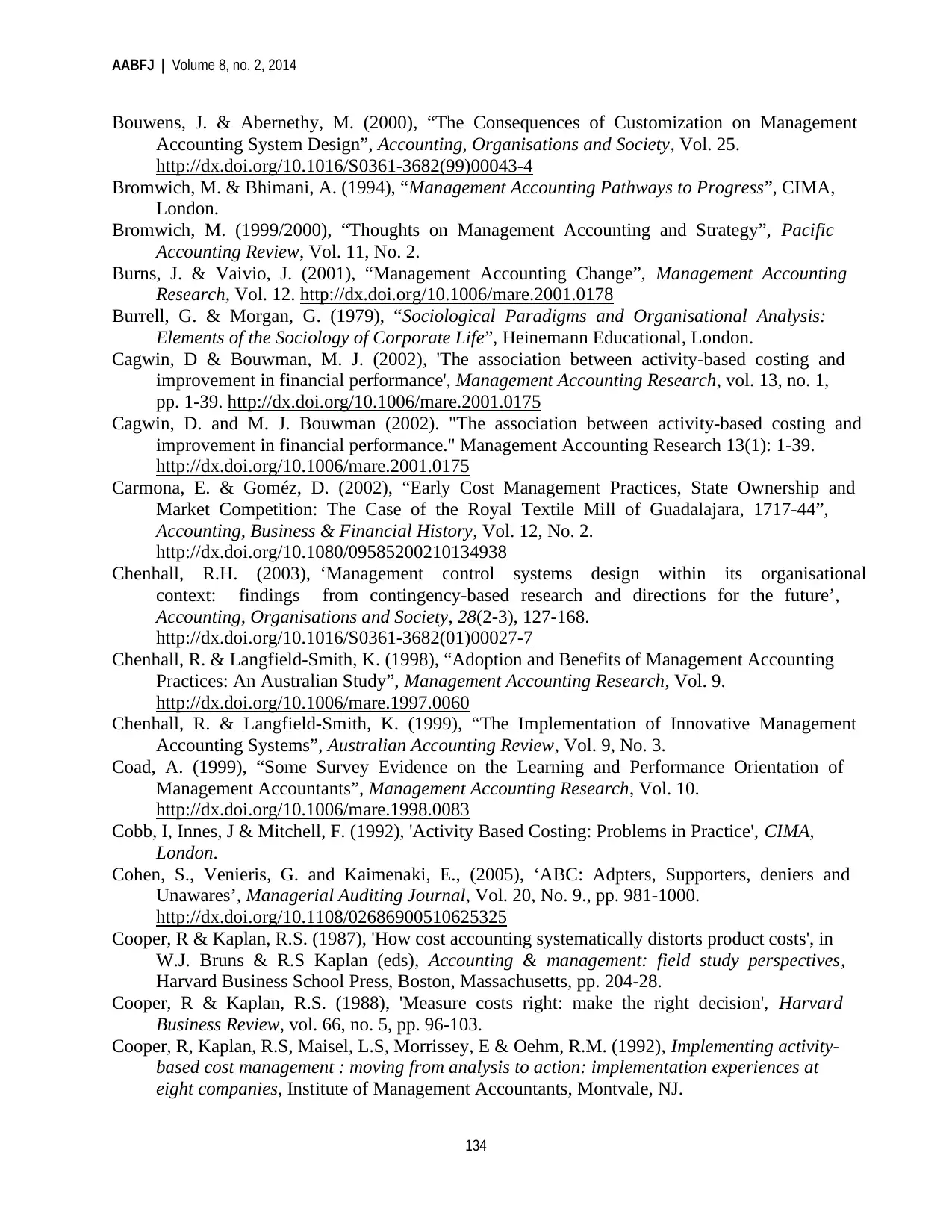
AABFJ | Volume 8, no. 2, 2014
134
Bouwens, J. & Abernethy, M. (2000), “The Consequences of Customization on Management
Accounting System Design”, Accounting, Organisations and Society, Vol. 25.
http://dx.doi.org/10.1016/S0361-3682(99)00043-4
Bromwich, M. & Bhimani, A. (1994), “Management Accounting Pathways to Progress”, CIMA,
London.
Bromwich, M. (1999/2000), “Thoughts on Management Accounting and Strategy”, Pacific
Accounting Review, Vol. 11, No. 2.
Burns, J. & Vaivio, J. (2001), “Management Accounting Change”, Management Accounting
Research, Vol. 12. http://dx.doi.org/10.1006/mare.2001.0178
Burrell, G. & Morgan, G. (1979), “Sociological Paradigms and Organisational Analysis:
Elements of the Sociology of Corporate Life”, Heinemann Educational, London.
Cagwin, D & Bouwman, M. J. (2002), 'The association between activity-based costing and
improvement in financial performance', Management Accounting Research, vol. 13, no. 1,
pp. 1-39. http://dx.doi.org/10.1006/mare.2001.0175
Cagwin, D. and M. J. Bouwman (2002). "The association between activity-based costing and
improvement in financial performance." Management Accounting Research 13(1): 1-39.
http://dx.doi.org/10.1006/mare.2001.0175
Carmona, E. & Goméz, D. (2002), “Early Cost Management Practices, State Ownership and
Market Competition: The Case of the Royal Textile Mill of Guadalajara, 1717-44”,
Accounting, Business & Financial History, Vol. 12, No. 2.
http://dx.doi.org/10.1080/09585200210134938
Chenhall, R.H. (2003), ‘Management control systems design within its organisational
context: findings from contingency-based research and directions for the future’,
Accounting, Organisations and Society, 28(2-3), 127-168.
http://dx.doi.org/10.1016/S0361-3682(01)00027-7
Chenhall, R. & Langfield-Smith, K. (1998), “Adoption and Benefits of Management Accounting
Practices: An Australian Study”, Management Accounting Research, Vol. 9.
http://dx.doi.org/10.1006/mare.1997.0060
Chenhall, R. & Langfield-Smith, K. (1999), “The Implementation of Innovative Management
Accounting Systems”, Australian Accounting Review, Vol. 9, No. 3.
Coad, A. (1999), “Some Survey Evidence on the Learning and Performance Orientation of
Management Accountants”, Management Accounting Research, Vol. 10.
http://dx.doi.org/10.1006/mare.1998.0083
Cobb, I, Innes, J & Mitchell, F. (1992), 'Activity Based Costing: Problems in Practice', CIMA,
London.
Cohen, S., Venieris, G. and Kaimenaki, E., (2005), ‘ABC: Adpters, Supporters, deniers and
Unawares’, Managerial Auditing Journal, Vol. 20, No. 9., pp. 981-1000.
http://dx.doi.org/10.1108/02686900510625325
Cooper, R & Kaplan, R.S. (1987), 'How cost accounting systematically distorts product costs', in
W.J. Bruns & R.S Kaplan (eds), Accounting & management: field study perspectives,
Harvard Business School Press, Boston, Massachusetts, pp. 204-28.
Cooper, R & Kaplan, R.S. (1988), 'Measure costs right: make the right decision', Harvard
Business Review, vol. 66, no. 5, pp. 96-103.
Cooper, R, Kaplan, R.S, Maisel, L.S, Morrissey, E & Oehm, R.M. (1992), Implementing activity-
based cost management : moving from analysis to action: implementation experiences at
eight companies, Institute of Management Accountants, Montvale, NJ.
134
Bouwens, J. & Abernethy, M. (2000), “The Consequences of Customization on Management
Accounting System Design”, Accounting, Organisations and Society, Vol. 25.
http://dx.doi.org/10.1016/S0361-3682(99)00043-4
Bromwich, M. & Bhimani, A. (1994), “Management Accounting Pathways to Progress”, CIMA,
London.
Bromwich, M. (1999/2000), “Thoughts on Management Accounting and Strategy”, Pacific
Accounting Review, Vol. 11, No. 2.
Burns, J. & Vaivio, J. (2001), “Management Accounting Change”, Management Accounting
Research, Vol. 12. http://dx.doi.org/10.1006/mare.2001.0178
Burrell, G. & Morgan, G. (1979), “Sociological Paradigms and Organisational Analysis:
Elements of the Sociology of Corporate Life”, Heinemann Educational, London.
Cagwin, D & Bouwman, M. J. (2002), 'The association between activity-based costing and
improvement in financial performance', Management Accounting Research, vol. 13, no. 1,
pp. 1-39. http://dx.doi.org/10.1006/mare.2001.0175
Cagwin, D. and M. J. Bouwman (2002). "The association between activity-based costing and
improvement in financial performance." Management Accounting Research 13(1): 1-39.
http://dx.doi.org/10.1006/mare.2001.0175
Carmona, E. & Goméz, D. (2002), “Early Cost Management Practices, State Ownership and
Market Competition: The Case of the Royal Textile Mill of Guadalajara, 1717-44”,
Accounting, Business & Financial History, Vol. 12, No. 2.
http://dx.doi.org/10.1080/09585200210134938
Chenhall, R.H. (2003), ‘Management control systems design within its organisational
context: findings from contingency-based research and directions for the future’,
Accounting, Organisations and Society, 28(2-3), 127-168.
http://dx.doi.org/10.1016/S0361-3682(01)00027-7
Chenhall, R. & Langfield-Smith, K. (1998), “Adoption and Benefits of Management Accounting
Practices: An Australian Study”, Management Accounting Research, Vol. 9.
http://dx.doi.org/10.1006/mare.1997.0060
Chenhall, R. & Langfield-Smith, K. (1999), “The Implementation of Innovative Management
Accounting Systems”, Australian Accounting Review, Vol. 9, No. 3.
Coad, A. (1999), “Some Survey Evidence on the Learning and Performance Orientation of
Management Accountants”, Management Accounting Research, Vol. 10.
http://dx.doi.org/10.1006/mare.1998.0083
Cobb, I, Innes, J & Mitchell, F. (1992), 'Activity Based Costing: Problems in Practice', CIMA,
London.
Cohen, S., Venieris, G. and Kaimenaki, E., (2005), ‘ABC: Adpters, Supporters, deniers and
Unawares’, Managerial Auditing Journal, Vol. 20, No. 9., pp. 981-1000.
http://dx.doi.org/10.1108/02686900510625325
Cooper, R & Kaplan, R.S. (1987), 'How cost accounting systematically distorts product costs', in
W.J. Bruns & R.S Kaplan (eds), Accounting & management: field study perspectives,
Harvard Business School Press, Boston, Massachusetts, pp. 204-28.
Cooper, R & Kaplan, R.S. (1988), 'Measure costs right: make the right decision', Harvard
Business Review, vol. 66, no. 5, pp. 96-103.
Cooper, R, Kaplan, R.S, Maisel, L.S, Morrissey, E & Oehm, R.M. (1992), Implementing activity-
based cost management : moving from analysis to action: implementation experiences at
eight companies, Institute of Management Accountants, Montvale, NJ.
Secure Best Marks with AI Grader
Need help grading? Try our AI Grader for instant feedback on your assignments.
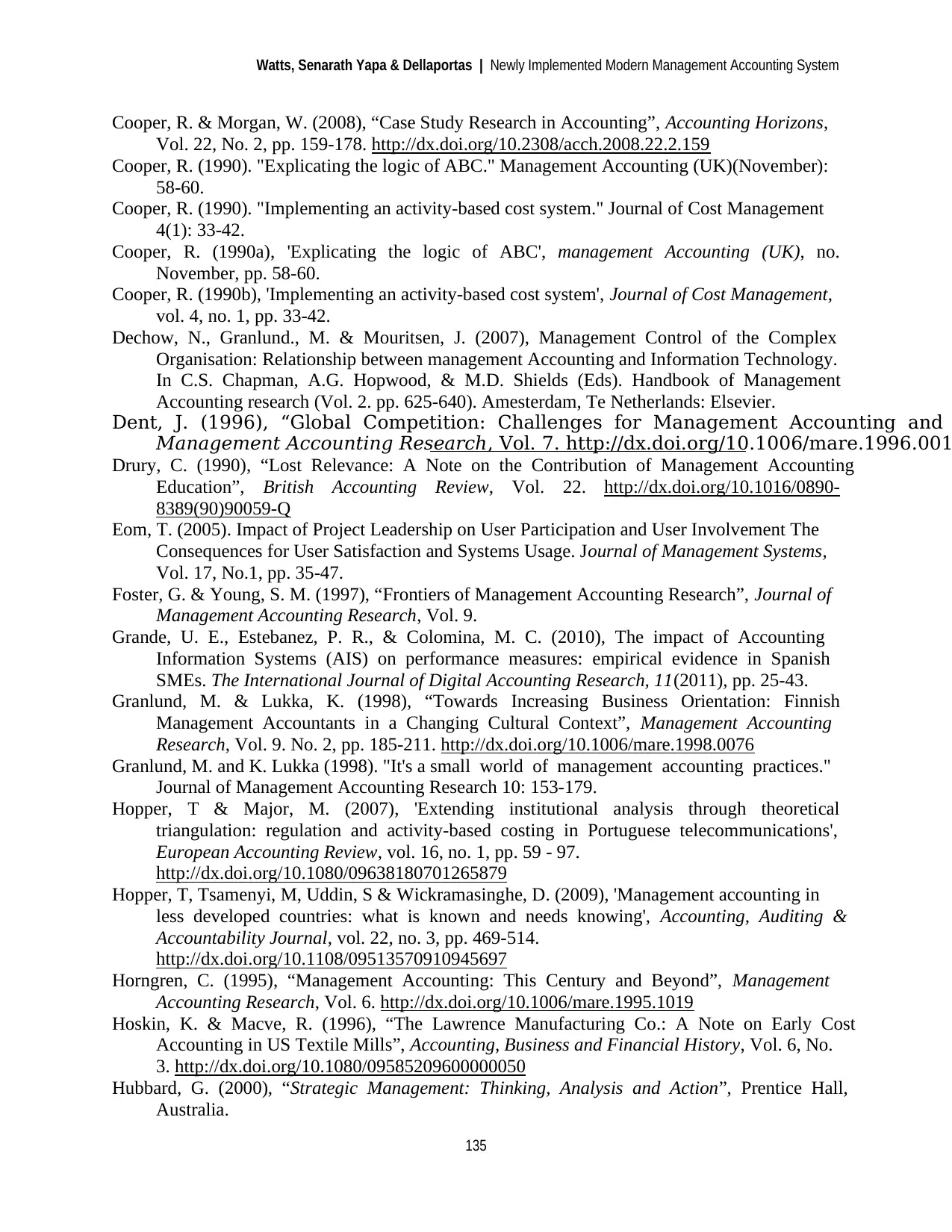
Watts, Senarath Yapa & Dellaportas | Newly Implemented Modern Management Accounting System
135
Cooper, R. & Morgan, W. (2008), “Case Study Research in Accounting”, Accounting Horizons,
Vol. 22, No. 2, pp. 159-178. http://dx.doi.org/10.2308/acch.2008.22.2.159
Cooper, R. (1990). "Explicating the logic of ABC." Management Accounting (UK)(November):
58-60.
Cooper, R. (1990). "Implementing an activity-based cost system." Journal of Cost Management
4(1): 33-42.
Cooper, R. (1990a), 'Explicating the logic of ABC', management Accounting (UK), no.
November, pp. 58-60.
Cooper, R. (1990b), 'Implementing an activity-based cost system', Journal of Cost Management,
vol. 4, no. 1, pp. 33-42.
Dechow, N., Granlund., M. & Mouritsen, J. (2007), Management Control of the Complex
Organisation: Relationship between management Accounting and Information Technology.
In C.S. Chapman, A.G. Hopwood, & M.D. Shields (Eds). Handbook of Management
Accounting research (Vol. 2. pp. 625-640). Amesterdam, Te Netherlands: Elsevier.
Dent, J. (1996), “Global Competition: Challenges for Management Accounting and
Management Accounting Research, Vol. 7. http://dx.doi.org/10.1006/mare.1996.001
Drury, C. (1990), “Lost Relevance: A Note on the Contribution of Management Accounting
Education”, British Accounting Review, Vol. 22. http://dx.doi.org/10.1016/0890-
8389(90)90059-Q
Eom, T. (2005). Impact of Project Leadership on User Participation and User Involvement The
Consequences for User Satisfaction and Systems Usage. Journal of Management Systems,
Vol. 17, No.1, pp. 35-47.
Foster, G. & Young, S. M. (1997), “Frontiers of Management Accounting Research”, Journal of
Management Accounting Research, Vol. 9.
Grande, U. E., Estebanez, P. R., & Colomina, M. C. (2010), The impact of Accounting
Information Systems (AIS) on performance measures: empirical evidence in Spanish
SMEs. The International Journal of Digital Accounting Research, 11(2011), pp. 25-43.
Granlund, M. & Lukka, K. (1998), “Towards Increasing Business Orientation: Finnish
Management Accountants in a Changing Cultural Context”, Management Accounting
Research, Vol. 9. No. 2, pp. 185-211. http://dx.doi.org/10.1006/mare.1998.0076
Granlund, M. and K. Lukka (1998). "It's a small world of management accounting practices."
Journal of Management Accounting Research 10: 153-179.
Hopper, T & Major, M. (2007), 'Extending institutional analysis through theoretical
triangulation: regulation and activity-based costing in Portuguese telecommunications',
European Accounting Review, vol. 16, no. 1, pp. 59 - 97.
http://dx.doi.org/10.1080/09638180701265879
Hopper, T, Tsamenyi, M, Uddin, S & Wickramasinghe, D. (2009), 'Management accounting in
less developed countries: what is known and needs knowing', Accounting, Auditing &
Accountability Journal, vol. 22, no. 3, pp. 469-514.
http://dx.doi.org/10.1108/09513570910945697
Horngren, C. (1995), “Management Accounting: This Century and Beyond”, Management
Accounting Research, Vol. 6. http://dx.doi.org/10.1006/mare.1995.1019
Hoskin, K. & Macve, R. (1996), “The Lawrence Manufacturing Co.: A Note on Early Cost
Accounting in US Textile Mills”, Accounting, Business and Financial History, Vol. 6, No.
3. http://dx.doi.org/10.1080/09585209600000050
Hubbard, G. (2000), “Strategic Management: Thinking, Analysis and Action”, Prentice Hall,
Australia.
135
Cooper, R. & Morgan, W. (2008), “Case Study Research in Accounting”, Accounting Horizons,
Vol. 22, No. 2, pp. 159-178. http://dx.doi.org/10.2308/acch.2008.22.2.159
Cooper, R. (1990). "Explicating the logic of ABC." Management Accounting (UK)(November):
58-60.
Cooper, R. (1990). "Implementing an activity-based cost system." Journal of Cost Management
4(1): 33-42.
Cooper, R. (1990a), 'Explicating the logic of ABC', management Accounting (UK), no.
November, pp. 58-60.
Cooper, R. (1990b), 'Implementing an activity-based cost system', Journal of Cost Management,
vol. 4, no. 1, pp. 33-42.
Dechow, N., Granlund., M. & Mouritsen, J. (2007), Management Control of the Complex
Organisation: Relationship between management Accounting and Information Technology.
In C.S. Chapman, A.G. Hopwood, & M.D. Shields (Eds). Handbook of Management
Accounting research (Vol. 2. pp. 625-640). Amesterdam, Te Netherlands: Elsevier.
Dent, J. (1996), “Global Competition: Challenges for Management Accounting and
Management Accounting Research, Vol. 7. http://dx.doi.org/10.1006/mare.1996.001
Drury, C. (1990), “Lost Relevance: A Note on the Contribution of Management Accounting
Education”, British Accounting Review, Vol. 22. http://dx.doi.org/10.1016/0890-
8389(90)90059-Q
Eom, T. (2005). Impact of Project Leadership on User Participation and User Involvement The
Consequences for User Satisfaction and Systems Usage. Journal of Management Systems,
Vol. 17, No.1, pp. 35-47.
Foster, G. & Young, S. M. (1997), “Frontiers of Management Accounting Research”, Journal of
Management Accounting Research, Vol. 9.
Grande, U. E., Estebanez, P. R., & Colomina, M. C. (2010), The impact of Accounting
Information Systems (AIS) on performance measures: empirical evidence in Spanish
SMEs. The International Journal of Digital Accounting Research, 11(2011), pp. 25-43.
Granlund, M. & Lukka, K. (1998), “Towards Increasing Business Orientation: Finnish
Management Accountants in a Changing Cultural Context”, Management Accounting
Research, Vol. 9. No. 2, pp. 185-211. http://dx.doi.org/10.1006/mare.1998.0076
Granlund, M. and K. Lukka (1998). "It's a small world of management accounting practices."
Journal of Management Accounting Research 10: 153-179.
Hopper, T & Major, M. (2007), 'Extending institutional analysis through theoretical
triangulation: regulation and activity-based costing in Portuguese telecommunications',
European Accounting Review, vol. 16, no. 1, pp. 59 - 97.
http://dx.doi.org/10.1080/09638180701265879
Hopper, T, Tsamenyi, M, Uddin, S & Wickramasinghe, D. (2009), 'Management accounting in
less developed countries: what is known and needs knowing', Accounting, Auditing &
Accountability Journal, vol. 22, no. 3, pp. 469-514.
http://dx.doi.org/10.1108/09513570910945697
Horngren, C. (1995), “Management Accounting: This Century and Beyond”, Management
Accounting Research, Vol. 6. http://dx.doi.org/10.1006/mare.1995.1019
Hoskin, K. & Macve, R. (1996), “The Lawrence Manufacturing Co.: A Note on Early Cost
Accounting in US Textile Mills”, Accounting, Business and Financial History, Vol. 6, No.
3. http://dx.doi.org/10.1080/09585209600000050
Hubbard, G. (2000), “Strategic Management: Thinking, Analysis and Action”, Prentice Hall,
Australia.
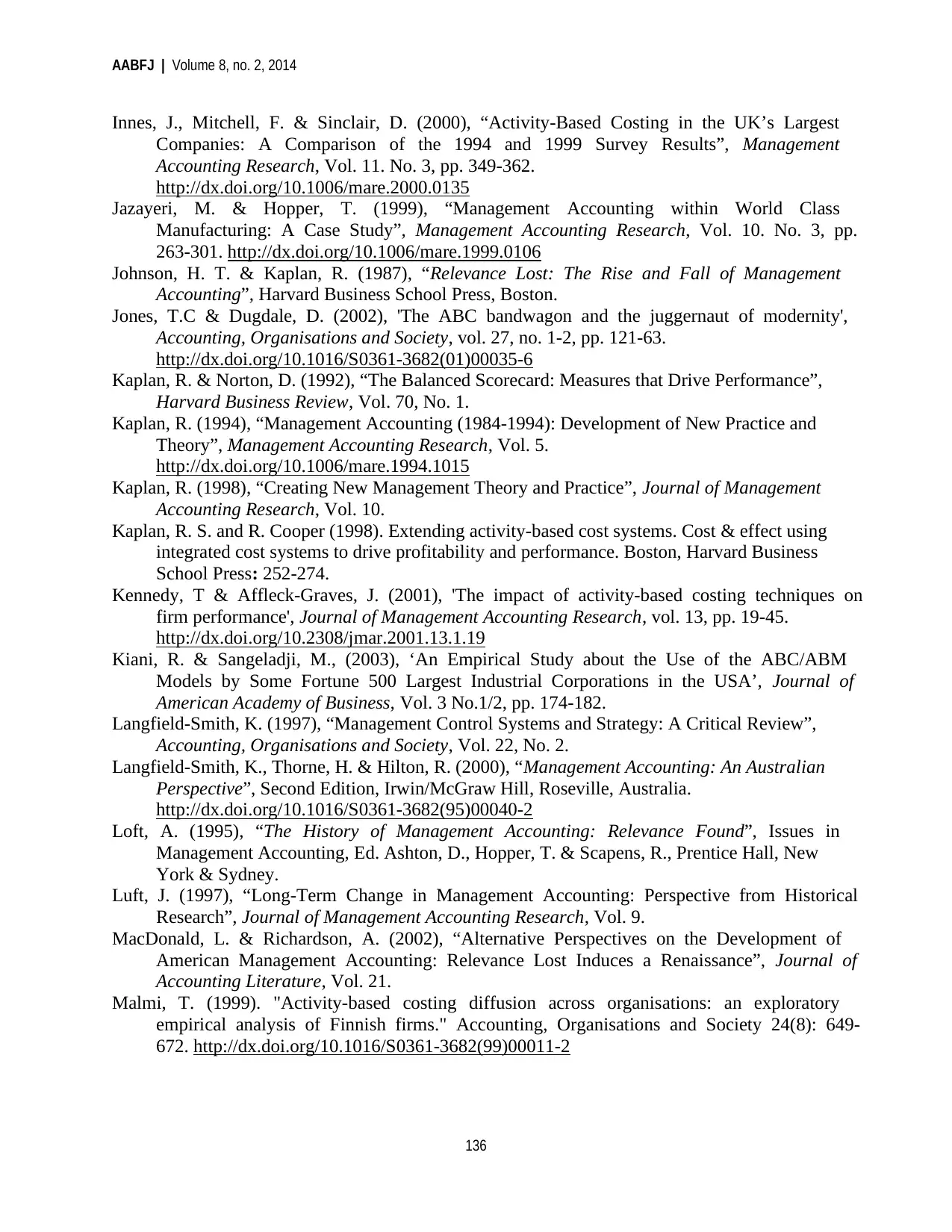
AABFJ | Volume 8, no. 2, 2014
136
Innes, J., Mitchell, F. & Sinclair, D. (2000), “Activity-Based Costing in the UK’s Largest
Companies: A Comparison of the 1994 and 1999 Survey Results”, Management
Accounting Research, Vol. 11. No. 3, pp. 349-362.
http://dx.doi.org/10.1006/mare.2000.0135
Jazayeri, M. & Hopper, T. (1999), “Management Accounting within World Class
Manufacturing: A Case Study”, Management Accounting Research, Vol. 10. No. 3, pp.
263-301. http://dx.doi.org/10.1006/mare.1999.0106
Johnson, H. T. & Kaplan, R. (1987), “Relevance Lost: The Rise and Fall of Management
Accounting”, Harvard Business School Press, Boston.
Jones, T.C & Dugdale, D. (2002), 'The ABC bandwagon and the juggernaut of modernity',
Accounting, Organisations and Society, vol. 27, no. 1-2, pp. 121-63.
http://dx.doi.org/10.1016/S0361-3682(01)00035-6
Kaplan, R. & Norton, D. (1992), “The Balanced Scorecard: Measures that Drive Performance”,
Harvard Business Review, Vol. 70, No. 1.
Kaplan, R. (1994), “Management Accounting (1984-1994): Development of New Practice and
Theory”, Management Accounting Research, Vol. 5.
http://dx.doi.org/10.1006/mare.1994.1015
Kaplan, R. (1998), “Creating New Management Theory and Practice”, Journal of Management
Accounting Research, Vol. 10.
Kaplan, R. S. and R. Cooper (1998). Extending activity-based cost systems. Cost & effect using
integrated cost systems to drive profitability and performance. Boston, Harvard Business
School Press: 252-274.
Kennedy, T & Affleck-Graves, J. (2001), 'The impact of activity-based costing techniques on
firm performance', Journal of Management Accounting Research, vol. 13, pp. 19-45.
http://dx.doi.org/10.2308/jmar.2001.13.1.19
Kiani, R. & Sangeladji, M., (2003), ‘An Empirical Study about the Use of the ABC/ABM
Models by Some Fortune 500 Largest Industrial Corporations in the USA’, Journal of
American Academy of Business, Vol. 3 No.1/2, pp. 174-182.
Langfield-Smith, K. (1997), “Management Control Systems and Strategy: A Critical Review”,
Accounting, Organisations and Society, Vol. 22, No. 2.
Langfield-Smith, K., Thorne, H. & Hilton, R. (2000), “Management Accounting: An Australian
Perspective”, Second Edition, Irwin/McGraw Hill, Roseville, Australia.
http://dx.doi.org/10.1016/S0361-3682(95)00040-2
Loft, A. (1995), “The History of Management Accounting: Relevance Found”, Issues in
Management Accounting, Ed. Ashton, D., Hopper, T. & Scapens, R., Prentice Hall, New
York & Sydney.
Luft, J. (1997), “Long-Term Change in Management Accounting: Perspective from Historical
Research”, Journal of Management Accounting Research, Vol. 9.
MacDonald, L. & Richardson, A. (2002), “Alternative Perspectives on the Development of
American Management Accounting: Relevance Lost Induces a Renaissance”, Journal of
Accounting Literature, Vol. 21.
Malmi, T. (1999). "Activity-based costing diffusion across organisations: an exploratory
empirical analysis of Finnish firms." Accounting, Organisations and Society 24(8): 649-
672. http://dx.doi.org/10.1016/S0361-3682(99)00011-2
136
Innes, J., Mitchell, F. & Sinclair, D. (2000), “Activity-Based Costing in the UK’s Largest
Companies: A Comparison of the 1994 and 1999 Survey Results”, Management
Accounting Research, Vol. 11. No. 3, pp. 349-362.
http://dx.doi.org/10.1006/mare.2000.0135
Jazayeri, M. & Hopper, T. (1999), “Management Accounting within World Class
Manufacturing: A Case Study”, Management Accounting Research, Vol. 10. No. 3, pp.
263-301. http://dx.doi.org/10.1006/mare.1999.0106
Johnson, H. T. & Kaplan, R. (1987), “Relevance Lost: The Rise and Fall of Management
Accounting”, Harvard Business School Press, Boston.
Jones, T.C & Dugdale, D. (2002), 'The ABC bandwagon and the juggernaut of modernity',
Accounting, Organisations and Society, vol. 27, no. 1-2, pp. 121-63.
http://dx.doi.org/10.1016/S0361-3682(01)00035-6
Kaplan, R. & Norton, D. (1992), “The Balanced Scorecard: Measures that Drive Performance”,
Harvard Business Review, Vol. 70, No. 1.
Kaplan, R. (1994), “Management Accounting (1984-1994): Development of New Practice and
Theory”, Management Accounting Research, Vol. 5.
http://dx.doi.org/10.1006/mare.1994.1015
Kaplan, R. (1998), “Creating New Management Theory and Practice”, Journal of Management
Accounting Research, Vol. 10.
Kaplan, R. S. and R. Cooper (1998). Extending activity-based cost systems. Cost & effect using
integrated cost systems to drive profitability and performance. Boston, Harvard Business
School Press: 252-274.
Kennedy, T & Affleck-Graves, J. (2001), 'The impact of activity-based costing techniques on
firm performance', Journal of Management Accounting Research, vol. 13, pp. 19-45.
http://dx.doi.org/10.2308/jmar.2001.13.1.19
Kiani, R. & Sangeladji, M., (2003), ‘An Empirical Study about the Use of the ABC/ABM
Models by Some Fortune 500 Largest Industrial Corporations in the USA’, Journal of
American Academy of Business, Vol. 3 No.1/2, pp. 174-182.
Langfield-Smith, K. (1997), “Management Control Systems and Strategy: A Critical Review”,
Accounting, Organisations and Society, Vol. 22, No. 2.
Langfield-Smith, K., Thorne, H. & Hilton, R. (2000), “Management Accounting: An Australian
Perspective”, Second Edition, Irwin/McGraw Hill, Roseville, Australia.
http://dx.doi.org/10.1016/S0361-3682(95)00040-2
Loft, A. (1995), “The History of Management Accounting: Relevance Found”, Issues in
Management Accounting, Ed. Ashton, D., Hopper, T. & Scapens, R., Prentice Hall, New
York & Sydney.
Luft, J. (1997), “Long-Term Change in Management Accounting: Perspective from Historical
Research”, Journal of Management Accounting Research, Vol. 9.
MacDonald, L. & Richardson, A. (2002), “Alternative Perspectives on the Development of
American Management Accounting: Relevance Lost Induces a Renaissance”, Journal of
Accounting Literature, Vol. 21.
Malmi, T. (1999). "Activity-based costing diffusion across organisations: an exploratory
empirical analysis of Finnish firms." Accounting, Organisations and Society 24(8): 649-
672. http://dx.doi.org/10.1016/S0361-3682(99)00011-2
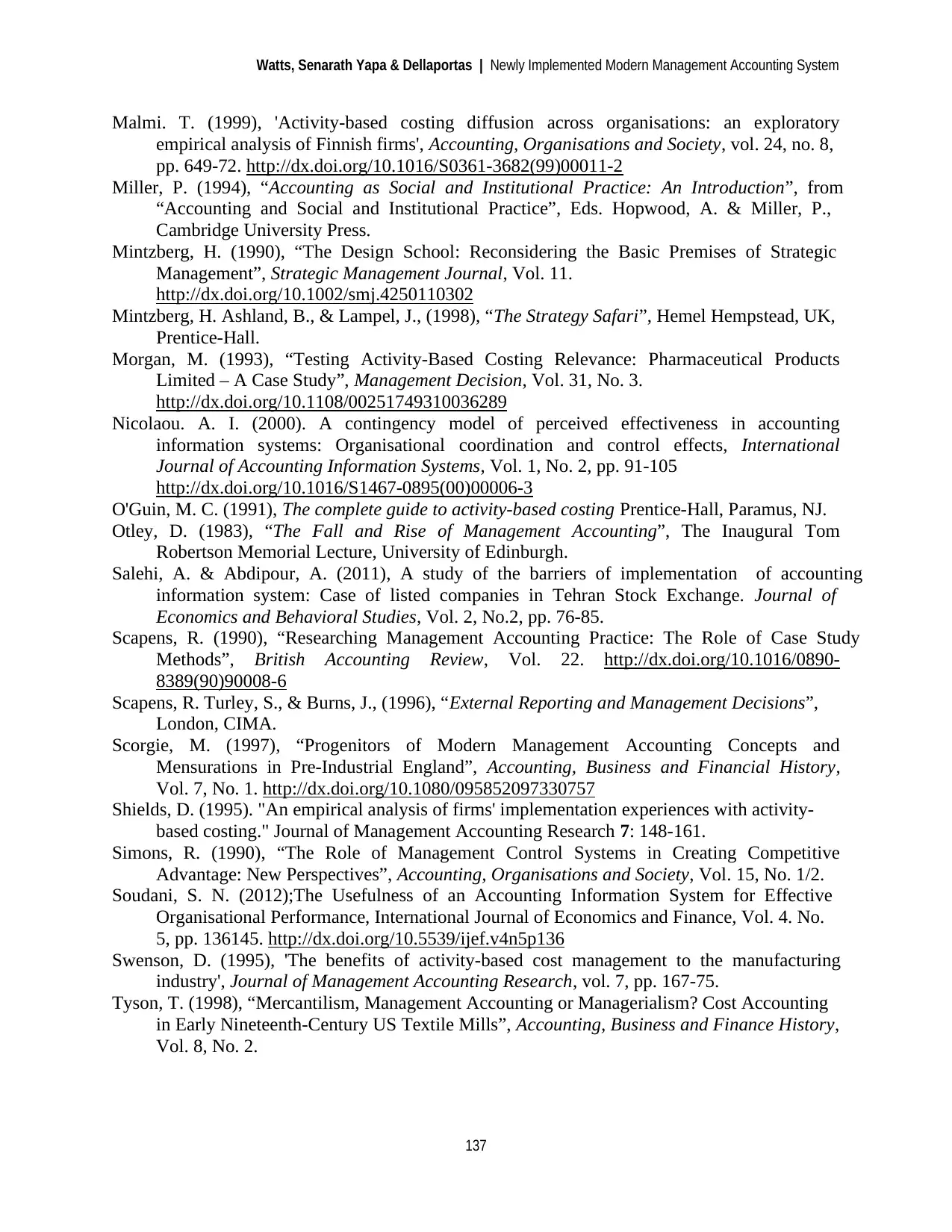
Watts, Senarath Yapa & Dellaportas | Newly Implemented Modern Management Accounting System
137
Malmi. T. (1999), 'Activity-based costing diffusion across organisations: an exploratory
empirical analysis of Finnish firms', Accounting, Organisations and Society, vol. 24, no. 8,
pp. 649-72. http://dx.doi.org/10.1016/S0361-3682(99)00011-2
Miller, P. (1994), “Accounting as Social and Institutional Practice: An Introduction”, from
“Accounting and Social and Institutional Practice”, Eds. Hopwood, A. & Miller, P.,
Cambridge University Press.
Mintzberg, H. (1990), “The Design School: Reconsidering the Basic Premises of Strategic
Management”, Strategic Management Journal, Vol. 11.
http://dx.doi.org/10.1002/smj.4250110302
Mintzberg, H. Ashland, B., & Lampel, J., (1998), “The Strategy Safari”, Hemel Hempstead, UK,
Prentice-Hall.
Morgan, M. (1993), “Testing Activity-Based Costing Relevance: Pharmaceutical Products
Limited – A Case Study”, Management Decision, Vol. 31, No. 3.
http://dx.doi.org/10.1108/00251749310036289
Nicolaou. A. I. (2000). A contingency model of perceived effectiveness in accounting
information systems: Organisational coordination and control effects, International
Journal of Accounting Information Systems, Vol. 1, No. 2, pp. 91-105
http://dx.doi.org/10.1016/S1467-0895(00)00006-3
O'Guin, M. C. (1991), The complete guide to activity-based costing Prentice-Hall, Paramus, NJ.
Otley, D. (1983), “The Fall and Rise of Management Accounting”, The Inaugural Tom
Robertson Memorial Lecture, University of Edinburgh.
Salehi, A. & Abdipour, A. (2011), A study of the barriers of implementation of accounting
information system: Case of listed companies in Tehran Stock Exchange. Journal of
Economics and Behavioral Studies, Vol. 2, No.2, pp. 76-85.
Scapens, R. (1990), “Researching Management Accounting Practice: The Role of Case Study
Methods”, British Accounting Review, Vol. 22. http://dx.doi.org/10.1016/0890-
8389(90)90008-6
Scapens, R. Turley, S., & Burns, J., (1996), “External Reporting and Management Decisions”,
London, CIMA.
Scorgie, M. (1997), “Progenitors of Modern Management Accounting Concepts and
Mensurations in Pre-Industrial England”, Accounting, Business and Financial History,
Vol. 7, No. 1. http://dx.doi.org/10.1080/095852097330757
Shields, D. (1995). "An empirical analysis of firms' implementation experiences with activity-
based costing." Journal of Management Accounting Research 7: 148-161.
Simons, R. (1990), “The Role of Management Control Systems in Creating Competitive
Advantage: New Perspectives”, Accounting, Organisations and Society, Vol. 15, No. 1/2.
Soudani, S. N. (2012);The Usefulness of an Accounting Information System for Effective
Organisational Performance, International Journal of Economics and Finance, Vol. 4. No.
5, pp. 136145. http://dx.doi.org/10.5539/ijef.v4n5p136
Swenson, D. (1995), 'The benefits of activity-based cost management to the manufacturing
industry', Journal of Management Accounting Research, vol. 7, pp. 167-75.
Tyson, T. (1998), “Mercantilism, Management Accounting or Managerialism? Cost Accounting
in Early Nineteenth-Century US Textile Mills”, Accounting, Business and Finance History,
Vol. 8, No. 2.
137
Malmi. T. (1999), 'Activity-based costing diffusion across organisations: an exploratory
empirical analysis of Finnish firms', Accounting, Organisations and Society, vol. 24, no. 8,
pp. 649-72. http://dx.doi.org/10.1016/S0361-3682(99)00011-2
Miller, P. (1994), “Accounting as Social and Institutional Practice: An Introduction”, from
“Accounting and Social and Institutional Practice”, Eds. Hopwood, A. & Miller, P.,
Cambridge University Press.
Mintzberg, H. (1990), “The Design School: Reconsidering the Basic Premises of Strategic
Management”, Strategic Management Journal, Vol. 11.
http://dx.doi.org/10.1002/smj.4250110302
Mintzberg, H. Ashland, B., & Lampel, J., (1998), “The Strategy Safari”, Hemel Hempstead, UK,
Prentice-Hall.
Morgan, M. (1993), “Testing Activity-Based Costing Relevance: Pharmaceutical Products
Limited – A Case Study”, Management Decision, Vol. 31, No. 3.
http://dx.doi.org/10.1108/00251749310036289
Nicolaou. A. I. (2000). A contingency model of perceived effectiveness in accounting
information systems: Organisational coordination and control effects, International
Journal of Accounting Information Systems, Vol. 1, No. 2, pp. 91-105
http://dx.doi.org/10.1016/S1467-0895(00)00006-3
O'Guin, M. C. (1991), The complete guide to activity-based costing Prentice-Hall, Paramus, NJ.
Otley, D. (1983), “The Fall and Rise of Management Accounting”, The Inaugural Tom
Robertson Memorial Lecture, University of Edinburgh.
Salehi, A. & Abdipour, A. (2011), A study of the barriers of implementation of accounting
information system: Case of listed companies in Tehran Stock Exchange. Journal of
Economics and Behavioral Studies, Vol. 2, No.2, pp. 76-85.
Scapens, R. (1990), “Researching Management Accounting Practice: The Role of Case Study
Methods”, British Accounting Review, Vol. 22. http://dx.doi.org/10.1016/0890-
8389(90)90008-6
Scapens, R. Turley, S., & Burns, J., (1996), “External Reporting and Management Decisions”,
London, CIMA.
Scorgie, M. (1997), “Progenitors of Modern Management Accounting Concepts and
Mensurations in Pre-Industrial England”, Accounting, Business and Financial History,
Vol. 7, No. 1. http://dx.doi.org/10.1080/095852097330757
Shields, D. (1995). "An empirical analysis of firms' implementation experiences with activity-
based costing." Journal of Management Accounting Research 7: 148-161.
Simons, R. (1990), “The Role of Management Control Systems in Creating Competitive
Advantage: New Perspectives”, Accounting, Organisations and Society, Vol. 15, No. 1/2.
Soudani, S. N. (2012);The Usefulness of an Accounting Information System for Effective
Organisational Performance, International Journal of Economics and Finance, Vol. 4. No.
5, pp. 136145. http://dx.doi.org/10.5539/ijef.v4n5p136
Swenson, D. (1995), 'The benefits of activity-based cost management to the manufacturing
industry', Journal of Management Accounting Research, vol. 7, pp. 167-75.
Tyson, T. (1998), “Mercantilism, Management Accounting or Managerialism? Cost Accounting
in Early Nineteenth-Century US Textile Mills”, Accounting, Business and Finance History,
Vol. 8, No. 2.
1 out of 19
Related Documents
Your All-in-One AI-Powered Toolkit for Academic Success.
+13062052269
info@desklib.com
Available 24*7 on WhatsApp / Email
![[object Object]](/_next/static/media/star-bottom.7253800d.svg)
Unlock your academic potential
© 2024 | Zucol Services PVT LTD | All rights reserved.



